






























Winter for many parents can be a challenge. The weather is cold and wet, it’s flu season, traffic can be manic, and keeping the kids entertained indoors with ongoing load shedding is a lot!

To learn a bit about the flu vaccine as a preventative measure, see the article on page 36. The article on page 42 also provides some insightful tips for parents regarding kids and flu. Page 44 highlights some tips for parents regarding relief for children, especially useful for those body aches that accompany flu.
As much as the weather is cold, there is potential for a lot of warmth in winter. Warmth in the sense that it gives families the opportunity to spend more time together and connect. “The power of cuddles celebrated” on page 30 gives some insight on kangaroo care, which helps parents and babies bond.
Parents do their best to provide a stable homelife for children. Unfortunately, sometimes despite the best intentions life happens. While divorce is no longer taboo as it used to be historically, and often it can be a good move to ensure the well-being of parents which ultimately is good for the kids, the change for families can be jarring. The important thing is to ensure that all individuals impacted communicate openly and respectfully. “Breaking up or blending – helping kids cope with change” on page 64 provides some useful insights for parents to help children navigate separation or divorce, or a new partnership.
It sounds idealistic, but irrespective of what is going on in life there is a lot to be grateful for. Having a healthy, caring, and supportive family is worth a lot. So, enjoy this winter season, and be sure to enjoy quality time with your loved ones!
In the middle of winter, we all find ourselves either trying to avoid flu, or we are busy fighting flu. During colder temperatures in winter, the flu virus multiplies a lot faster and flourishes in your body once breathed in. Since the air is also drier when it is cold, germs hang in the air for much longer.
Make KuraFlo Hypertonic Saline solutions part of your cold and flu prevention this year.


Kuraflo Hypertonic saline draws fluid from the lining of the nose, sinuses, larynx and bronchi to help wash out those trapped bacteria and virus particles. The salt can also help dehydrate the bacteria and virus cells and kill them before they cause a respiratory infection.
If you are fighting the flu virus, Kuraflo Hypertonic saline will help bring down the swelling in the nasal cavities and thin the mucus and phlegm so that it can be coughed or blown out easier, giving you some much needed relief.
Also try our NEW anti-inflammatory, antibacterial & antiseptic KuraFlo Skin Healing Cream now available from selected Clicks stores. Try it and see the difference.
• Skin infections
• Skin Irritations
• Insect bites
• Scar treatment
• Nappy rash
• Cuts & Abrasions
KuraFlo – Helping you Breathe Better and now Feel Better too!
64 Breaking up or blending: helping kids cope with change

68 Emotional dysregulation: how to know if your child is struggling



72 The stress & overeating trap – seeking healthier relationships with food BEAUTY
74 Body sculptingafter massive weight loss
78 Debunking common skincare myths
82 5 ways to drop five years off your face

WHEN YOUR LITTLE CHAMP OR BEAUTIFUL PRINCESS IS SICK... and needs to be admitted to hospital, our team at Life Kingsbury Hospital is here for you.

The Life Kidz paediatric unit at Life Kingsbury Hospital has been designed with you and your child in mind. Our clinical team of specialists and nurses will care for and nurture your child in a unit specially designed to make them forget that they are even in hospital – beds and blankets aside!
Paediatricians:
Dr Rabeen Lutchman
Dr Allan Puterman
Dr Lara Smith
Dr Hedi van der Watt
Paediatric Surgeon:
Dr Shalin Singh
ENT Specialist: Dr Gary Kroukamp

For hospital information and specialist contact details.
Wilderness Road, Claremont, 7700 | Tel: 021 670 4000 24-hour emergency unit: 021 670 4039
www.lifehealthcare.co.za
6 Carlton Crescent, Parklands, 7441
Email: info@babysandbeyond.co.za
Picture Credit: 123rf.com / pixabay.com
www.babysandbeyond.co.za

www.mediaxpose.co.za
Front cover & lead feature photos: Crystal Image Productions

Publisher: Elroy van Heerden-Mays elroy@mediaxpose.co.za
Editor: Tashne Singh editor@babysandbeyond.co.za
Sub-Editor: Tessa O'Hara tessa.ohara@gmail.com
Content Manager: Wadoeda Adams artwork@mediaxpose.co.za
Editorial Contributors: Mercedes Westbrook SANOFI Medhealthsup Dr Elewani Mathivha
Dharmendra J. Bhoola
Advertising Sales: Lorraine Beneke lorraine@babysandbeyond.co.za

Media Partnerships: Maurisha Niewenhuys maurisha@mediaxpose.co.za


Digital Marketing Manager: Jay-Dee van Rensburg digital@mediaxpose.co.za

Social Media Co-Ordinator: Kyla van Heerden social@mediaxpose.co.za
Distribution & Subscriptions: Shihaam Gyer distribution@mediaxpose.co.za
Admin Assistant: Ketsia Makola ketsia@mediaxpose.co.za
Website Developer/Administrator: Justin McGregor justin@mediaxpose.co.za
Chief Financial Officer: Shaun van Heerden-Mays shaun@mediaxpose.co.za
Design and Layout: Anja Bramley artwork1@mediaxpose.co.za
Shaun van Heerden-Mays artwork2@mediaxpose.co.za
Project Manager: Allison Davids allison@babysandbeyond.co.za

Receptionist: Daniëla Daniels receptionist@mediaxpose.co.za
Retail Distribution On The Dot
Airport Distribution Media Support
Disclaimer: The views expressed in this publication are not necessarily those of the publisher or its agents. While every effort has been made to ensure the accuracy of the information published, the publisher does not accept responsibility for any error or omission contained herein. Consequently, no person connected with the publication of this journal will be liable for any loss or damage sustained by any reader as a result of action following statements or opinions expressed herein. The publisher will give consideration to all material submitted, but does not take responsibility for damage or its safe return.











Beat the winter dryness and keep your baby's skin nourished with Pure Beginnings' range of tried and trusted organic skincare.

Known for its hydrating and nourishing properties, the Pure Beginnings range of pH-balanced skincare products is your ideal companion for keeping your baby’s skin soft, supple and beautifully moisturised this winter.
Pure Beginnings' Natural Chest Rub is the perfect non-medicated alternative during the chilly winter months. The 100% natural formulation combines the powerful healing properties of eucalyptus, tea tree, lavender, frankincense and it is a safe, gentle and effective way of easing congestion in babies and children.
Pure Beginnings is available from Baby City, Dis-Chem, Takealot, Woolworths Food, Wellness Warehouse, selected Babies R Us, Faithful-toNature, Checkers Little Me and health stores nationwide.
www.purebeginnings.co.za
Stand a chance to win 1 of 5

Includes a custom-made limited-edition travel bag, travel first aid kit and plush toy valued at R1 000!
To ENTER scan the QR code with your phone and complete the entry form online at www.babysandbeyond.co.za/competitions/ Closing date: 31 August 2023. T&Cs apply.
Stand
Baby wash & shampoo, baby body lotion, sensitive cream wash, massage & bath oil, toothpaste, bum cream and natural chest rub valued at R1 000.
To ENTER scan the QR code with your phone and complete the entry form online at www.babysandbeyond.co.za/competitions/ Closing date: 31 August 2023. T&Cs apply.


Ready to make your travels easier, more fun, and oh-so-stylish? Look no further because we've got the ultimate travel hamper up for grabs!
This custom-designed and limitededition travel bag from Reuterina® is more than just a bag; it's a sidekick, with easy-to-clean interior fabric, interior compartments, and side pouches that'll have you feeling organised and ready to go.
And when the unexpected strikes, the travel first aid kit has got you covered with all the essentials in one handy little package.
And last but definitely not least, the cuddly plush toy is the perfect
companion for all your adventures with little ones in tow! Yellow is a colour that instantly brightens up the day and brings a smile to children's faces. That's why this giveaway includes Reuterina®'s cheerful yellow mascot character that's sure to become a beloved companion.
All these goodies come beautifully boxed and presented as a gift, making them the ultimate travel surprise.
The Reuterina® family of probiotics are available from selected Dis-Chem and Clicks stores and independent pharmacies nationwide.
For more information visit www.reuterina.co.za
For cuts and scrapes. Can be cut to size. Great for larger areas of the body.


Ideal for cuts and scrapes around fingers and moveable joints. Comes in a variety of shapes and sizes.




Ideal for cuts and scrapes around fingers and moveable joints.


Ideal for cuts and scrapes on knuckles, hands and heals. Comes in a variety of shapes and sizes.

Vital’s PROTECT nailcare set contains everything you need to keep tiny fingers and toenails tamed. The ergonomic design is easy to hold, giving you ultimate control.
Specially designed scissor tips are carefully sized for tiny fingers and toenails. It is easy to hold and has built-in grips to give you extra peace of mind so that you can cut nails safely.
Curved clipper nail guards and small blades are perfectly sized for snipping and trimming with ease and comfort. Smooth over any sharp, rough, or catchy edges caused by cutting and clipping with the emery board for the perfect finish. BPA, latex and phthalate free.

valued at R127.99.
To ENTER scan the QR code with your phone and complete the entry form online at www.babysandbeyond.co.za/competitions/ Closing date: 31 August 2023. T&Cs apply.
Stand a chance to win a
valued at R274.99.
To ENTER scan the QR code with your phone and complete the entry form online at www.babysandbeyond.co.za/competitions/ Closing date: 31 August 2023. T&Cs apply.


Sometimes your baby may need an extra helping hand during feeding. The Vital Baby Nurture Silicone Feed Assist Bottle enables you to squeeze the base gently to assist latching and encourage milk flow.
A safe option for your baby, the silicone material used to create the bottle is one of the softest materials available, naturally free from chemicals such as BPA or phthalates, with high-temperature resistance and therefore safe to clean in a dishwasher.
For you and your baby’s convenience and comfort, Vital Baby Nurture Silicone Feed Assist Bottle has:
• Unique 100% soft silicone squeeze base, allowing you to control the flow for your baby.
• Anti-colic valves help to reduce air intake.
• Classic-shaped wide neck super soft teat for easy latching.
• Wide neck bottle for easy filling and cleaning.
The silicone teat is soft and smooth against baby’s delicate face. The Silicone Assist Bottles are also suitable when the baby is unable to suck or feed normally due to the complications of a cleft lip or palate, enabling an easier and more relaxed feeding time for both baby and parents, and ultimately reducing the need for tube feeding.












Stand
valued at R389.99 each.
To ENTER scan the QR code with your phone and complete the entry form online at www.babysandbeyond.co.za/competitions/ Closing date: 31 August 2023. T&Cs apply.
Bring home a bundle of joy with these My Garden Baby My First Baby Butterfly dolls! Little ones will flutter over their adorable wings, fantastical hair, and sweet jasmine scent. Wrap the plush wings around the doll for a snuggly swaddle. With a soft body and 23cm tall, these baby butterfly dolls are perfect for little arms to snuggle and hold. "Soothe" the doll with the tethered pacifier! Additionally, the packaging folds into a crib for even more nurturing play. Tuck My Garden Baby in so she can flutter into sweet garden dreams! Each sold separately, subject to availability. Colours and themes may vary.
Features and benefits:
• Bring home a bundle of joy with My Garden Baby My First Baby Butterfly dolls!
• Born with sweet jasmine scents, fantastical hair, and plush wings that wrap into swaddles.
• With soft tummies and 23cm tall, they're perfect for snuggles or take-along play.
• Plus, the packaging box folds into a crib where this baby butterfly can flutter into sweet garden dreams!
• Whimsical, soft, and cuddly – these My Garden Baby dolls make the perfect first dolls for little ones.

• Choose from blue, purple, and pink dolls.



Fix it fast or watch it blast with the Hot Wheels Build 'n Slam kids game. It includes unique versions of classic Hot Wheels cars that separate into different pieces, offering different levels of play, making it a perfect family game for kids and adults to play together! This Hot Wheels original game is a cool gift for kids aged 5 and older and a great choice for family game night. Colours and decorations may vary.
Stand
valued at R349.90.
To ENTER scan the QR code with your phone and complete the entry form online at www.babysandbeyond.co.za/competitions/ Closing date: 31 August 2023. T&Cs apply.


ENJOY HOT OR AS A REFRESHING ICED TEA, FRESHPAK JUNIOR IS AVAILABLE IN THE FOLLOWING FLAVOURS:
Freshpak Junior Rooibos







Freshpak Junior Organic Rooibos
Freshpak Junior Strawberry & Vanilla
Freshpak Junior Apple

Freshpak Junior Peach & Apricot
Freshpak Junior Naartjie

Looking for a healthy alternative to sugary drinks? Specially formulated for Kids, Freshpak Junior Rooibos Tea is naturally caffeine free and can be offered to children at any time of the day. Rooibos Tea is a natural source of polyphenols, a beneficial antioxidant.
Scan for refreshing iced tea recipes








Stand a chance to win 1 of 2!
valued at R619.
To ENTER scan the QR code with your phone and complete the entry form online at www.babysandbeyond.co.za/ competitions/


Closing date: 31 August 2023. T&Cs apply.
We believe preparation is the first step towards a beautiful birth experience. We equip couples with knowledge on pregnancy, labour and birth, empowering them to make well-informed decisions about their bodies, births and babies.
There are various elements to consider when growing and raising your family. Our classes are comprehensive, and we host guest speakers from various fields to share their knowledge and tips with our expecting parents.
The course is divided into three classes that run from 08h30-12h30. The cost is R800 per class, per couple or R2 200 if you book the full course. Mom and Dad attend together. Snacks and drinks are included. Private online classes are also available to suit your schedule.
www.bloomsy.co.za
Say hello to your baby's first best friend! Puppy is soft, cuddly, and he's ready to make sure learning fun never ends. He responds to your baby's touch with exciting sing-along songs and phrases that introduce more than 100 first words, parts of the body, colours, shapes and more. And because every baby develops at their own pace, Puppy comes with Smart Stages technology, so you can choose the level that's best for your child. There are a variety of songs, sounds and phrases within each of the three levels of play. And Puppy's light-up, multicolour heart even twinkles along to the music!
Benefits:
• Level 1 Explore: Baby can press Puppy's hands, foot, heart, nose or ears to hear first words, colours, the alphabet, parts of the body and more.
• Level 2 Encourage: In this level, fun phrases reward little ones as they're encouraged to count along, find colours, and identify parts of the body.
• Level 3 Pretend: Puppy's ready to play pretend with fun sing-along songs and phrases that engage toddlers in exciting and imaginative play, all while expanding their vocabulary.

Specifications:
• Dimensions: (H)33cm x (L)27.50cm x (W)15.50cm
• Weight: 0.62kg
• Suitable for children ages 6 months and older
• Warranty: 6 months
Stand a chance to win 1 of 2!

valued at R1 400 each.
To ENTER scan the QR code with your phone and complete the entry form online at www.babysandbeyond.co.za/competitions/ Closing date: 31 August 2023. T&Cs apply.
Did you know that one in two children may suffer from worm infestations?1 This can lead to stunted growth and mental health conditions in your children.1,2 The World Health Organisation recommends de-worming the entire family twice a year.2* Ask your pharmacist about Wormstop®, suitable for the whole family.3**

*Based on an infection rate in the community that is over 50%.
**Suitable for children from 2 years and above, not indicated for animals.
References:
1. Nxasana N, Baba K, Bhat VG and Vasaikar SD. Prevalence of Intestinal Parasites in Primary School Children of Mthatha, Eastern Cape Province, South Africa. Annals of Medical and Health Sciences Research. 2013(3):4, pgs511-516.
2. Soil-transmitted helminth infections. World Health Organisation. [online]. https://www.who.int/news-room/fact-sheets/detail/ soil-transmitted-helminth-infections [Accessed 25 July 2019].
A revolutionary new device called the AfriSpacer™, which makes inhalation of medication from an asthma pump easier and far more effective, has been launched in South Africa by the Allergy Foundation of South Africa (AFSA).

“It is conservatively estimated that 80% of asthma deaths could be prevented with better treatment,” says Professor Michael Levin, CEO of AFSA, and Head of the Paediatric Asthma and Allergy Division at the Red Cross Children’s Hospital. “It is for this reason that we are so excited to be launching the AfriSpacer™ into the market, and to be able to sell the units at a far lower cost than other commercially available spacers.”
Professor Levin explains that when using an asthma pump (metered dose inhaler) without a spacer, most of the spray hits the back of the throat, with only 9% of the medication actually reaching the lungs.
“The AfriSpacer™ is a device that slows the speed of the spray from an asthma pump and successfully directs
more medication into the lungs. Using the AfriSpacer™ allows 1.7 times more medicine to reach the lungs – making it more effective than a home nebuliser, or dry powder inhaler.”
The AfriSpacer™ is available to buy at national Dis-Chem, Spar Pharmacies, Local Choice Pharmacies, Alphen Wholesaler Pharmacies, and on the AFSA website.
Well-known in the entertainment industry with a career spanning over 40 years, Loukmaan Adams takes centre stage as husband to Shaakirah and father to their three girls, Nurah (5), Nimrah (4) and Qaariah (3).

“We met when I was walking on the beach, she was drowning and I saved her,” jokes Loukmaan Adams.
“We actually met through her cousin who is my best friend. He lives abroad and we only get to see each other during festive season. When I was visiting him, I met Shaakirah. At first, she did not give me a lot of attention, so it was a bit of a challenge, but we soon discovered we had a lot of mutual interests like our love for culture, music and family values. She comes from a very close-knit family, and it was great to see the family dynamics.”
Fast forward… Loukmaan and Shaakirah have been married for just over five years and have three daughters together.
“You only get to really know a person once you are married. When you are married you learn about things that you had no idea about, and your options are to negotiate or accept,” says Loukmaan.

“I mean, when you are married and you discover your partner snores, it’s best to say things like, 'wow, you sleep so beautifully!',” he quips.
Shaakirah adds, “I have learned a lot from Loukmaan. In general, I am an impatient person but watching Loukmaan I love the fact that he is always humble, makes time and has patience for everyone.”
With the kids just over a year apart, Loukmaan jokes that Mediclinic called them last year asking if everything was okay as Shaakirah had not been admitted for another birth.
“The kids arrived so quickly after each other and there was the pandemic, so we did not have much time to adjust. Now that they are older and there is a level of normality, we have more structure in place,” says Loukmaan.
“They can now go to school and creche, but with that comes another aspect where they want to do every


activity – and we can’t say no as the activities help with their development,” he adds.

“The amazing thing about parenthood is that I learn something new about my girls every day. It’s so surprising and I don’t understand that even though they are growing up together, they are each so different.”
When questioned about being a dad of girls, Loukmaan says, “With girls it’s easy. My job is to make them believe they are the most important person at any given moment. Sometimes the one comes crying to me, ‘Daddy, she hit me on the head,’ and then the other one comes to explain. It is important to give each child attention and that calms them. Some days are good days, and they are all happy and some days they are enemies.”
He adds, “I am not sure how it is with boys, but I find with daughters they know so much at a young age. And they are very independent in knowing what they want.”



Shaakirah adds, “The most important thing for us is to help instill confidence in our children. Loukmaan is a very hands-on dad and always makes us a priority, no matter what is going on. He is also the more ‘fun’ parent as he is more spontaneous. I am a planner – I like to know where we are going, and what we are doing so I know what to expect and can dress the kids accordingly.”
“For me it’s about ‘Let’s make today lekker!’ It’s less about the planning and more about creating happy moments,” says Loukmaan.
Having started his career in the entertainment industry at the age of nine, Loukmaan has a deep passion for theatre and regaling the public with colourful stories.
“The thing about theatre is that no matter what is happening in one’s life, for a couple of hours it makes people forget about their realities as they are taken on a journey from a musical and story perspective,” he says.
“I was playing soccer with dreams of becoming a soccer star when my dad came to collect me and said I should sing a song for an audition at the Baxter Theatre. I got the gig and worked for a couple of years on that production, which allowed me to travel both locally and abroad. That opened a lot of doors for me, and the Baxter became my second home.”
An award-winning performer, Loukmaan is well-known for having worked alongside directors and songwriters such as Taliep Petersen and David Kramer in productions such as “District Six”, “Kat and the Kings”, as well as performing with international artists like Stevie Wonder and Bonnie Tyler.


“A lot of the productions I am involved with highlight Coloured stories. Through theatre I am able to express our stories and culture, which you won't find in the history books,” says Loukmaan.
“I did TV for a bit, and it was challenging with a family. I have a lot of respect for local ‘soapie’ stars. Learning lines every day is intense – I mean you do the normal household/family chores such as shopping and making food, while simultaneously trying to learn lines. With theatre it is a bit more structured – you know what your schedule is.”
Like most families, the pandemic forced the Adams family to diversify. “During lockdown, it was very different – we went from performing for hundreds
and thousands of people to being limited to 100. Shaakirah and I then started our own company, LA Productions (Pty) Ltd, which gave rise to productions such as 'Unity on the Square' and ' Two of a Kind'. We started this as a means to sustain our living in terms of expenses. During lockdown, many of my friends had to sell their guitars and drumkits to make ends meet. Fortunately, Shaakirah comes from a tourism and hospitality background, and she came up with the idea of partnering with hotels to have a performance and meal package, whereby we could entertain 50 couples at a time.
“Working together means our personal and professional life is intertwined. We rarely switch off, but we are fortunate to have amazing people we work with. Shaakirah handles the operational and logistics aspects, and I am in charge of the production and creative side,” he says.
“Our next step is to launch an NPO – the Unity Foundation. The Unity Foundation is about empowering youth. It is a platform that seeks to create opportunities for youth to grow in the arts, performance and entertainment industries.
“We are not just looking at performers – we want to grow the platform to be inclusive. Digital media, for example, takes skill – sometimes people spend hours recording something to make a 20 second reel. At the end of the day, we want to create a lasting legacy that will continue through our youth. It’s important for us to guide our youth – it’s not always about instant fame. We have to put the time in to grow ourselves and work hard to achieve our goals,” concludes Loukmaan.
Glam squad
Hair and makeup: Kyra Loubser
Clothing: H&M, Mishah Collection, Mohd Apparel, Cotton On Kids, Fabiani Shoes: Veldskoen

4

The Vital Baby Nasal Decongester has been designed to clear blocked noses with a gentle squeeze. The ergonomic design is easy to hold, giving you the ultimate control. Designed with adult hands and little noses in mind. Fully disassembles for hygienic cleaning and sterilisation. The decongester is safe for microwave, steam and cold-water sterilisation, features a soft silicone tip, and is BPA free. www.vitalbabyshop.co.za
2
3
SKNLogic Retinol 0.5 Has a fast-absorbing, encapsulated retinol formula that reduces the appearance of fine lines, wrinkles and hyperpigmentation. Added Soyaglycone maximises the effect of retinol to improve the appearance of fine lines and wrinkles, refine uneven skin texture and treat hyper pigmentation. www.sknlogic.com

Wormstop® STOPS worms…
An effective and affordable treatment to eradicate most intestinal worms, suitable for the whole family. Available at pharmacies. www.sunpharma.com

Sudocrem

Is clinically proven to soothe and protect your baby’s delicate skin and soothes sore or irritable skin, helps ease pain and irritation. A water-repellent base forms a protective barrier, helping to stop any irritants (urine and faeces) coming into contact with the skin. Available at Clicks, Dis-Chem and other major retailers/pharmacies. www.sudocrem.com
Earthsap Tea Tree Hand Soap 250ml
Tea tree can assist in getting rid of germs, bacteria, fungus and infections. Earthsap created a lovely natural hand soap using tea tree oil as its key ingredient. Wheat germ was added to ensure that your skin is nourished and hydrated. This liquid hand wash is 100% non-toxic – no petrochemicals or artificial preservative to dry out your hands. Packaged in a handy pump bottle, Earthsap’s liquid hand soap is ideal for your bathroom or kitchen sink. Available at Wellness Warehouse, selected Spars and Pick n Pays, health shops nationwide and online at www.faithfulto-nature.co.za


Contains eleven basic healthcare items you need to care for a new-born’s basic healthcare needs. It includes a digital thermometer with case, nasal aspirator, soft toothbrush, medicine dropper, five alcohol wipes, emergency contact card and a travel case. Available online at www.medela.co.za
This Philips Avent baby bottle warmer warms milk in just three minutes. The bottle warmer warms evenly by circulating the milk continuously as it warms, so hot spots are prevented. Easy to operate, it features a handy defrost setting and can also be used to warm baby food. Available at Baby City, Woolworths, Babies R Us, Dischem and online at www.takealot.com or www.medhealthsup.com


Is a great choice for fast, effective sterilising at home or away. Up to four Philips Avent bottles or products can be sterilised at once, with 99.9% of germs killed in two minutes. Available at Baby City, Woolworths, Dischem, Babies R Us and online at www.takealot.com or www.medhealthsup.com

It is rich in antioxidants that reduce DNA damage caused by free radicals, thereby reducing the signs of aging (wrinkles and fine lines etc). The formula is infused with vitamin C and E for their moisturising, firming and toning abilities and is fragranced with delicate notes of grapefruit and neroli to leave you refreshed and ready for the day. Available at Clicks stores and online at www.bodylabscience.co.za

This gentle yet effective dry facial exfoliator is formulated with a blend of superfoods including baobab, oats, rice, and cranberry extracts. This powerful combination expertly removes dead skin cells, impurities, and dirt, revealing a healthy, glowing complexion. Regular use has numerous benefits for skin including boosting circulation while balancing pigmentation, acne and uneven skin tone. It also stimulates collagen production, which is crucial for proactive ageing and encourages fresh skin renewal. Available online at www.eccodiva.co.za
An easily dissolving cracker made with ancient grains, organic fruits and veggies. It is tasty for baby, easy on their gums and encourages selffeeding. All the Happy Family Organics baby products are gluten-free, Kosher, certified organic, contain no GMO or high fructose corn syrup, artificial food colourants or flavourants.
www.medhealthsup.com


“Ideally, from at least three months before the pregnancy, equip your body for bringing a child into the world by following a healthy lifestyle and avoiding risky behaviour. It is recommended you visit your gynaecologist well before you plan to conceive to discuss any medication adjustments and lifestyle changes that may be needed, as well as folic acid supplements to prepare for pregnancy,” Dr Pillay says.
“It is also especially important to screen the mother for any chronic medical conditions, such as diabetes, hypertension, as well as anaemia or vitamin deficiencies, so that these can be diagnosed and controlled prior to pregnancy. If you are concerned you may have depression, talk to your doctor and seek help early,” adds Dr Marise Subrayan, a gynaecologist and obstetrician practising at Netcare St Augustine’s Hospital.
• Excessive weight gain. Monitor your weight with your obstetrician throughout pregnancy.
• Fumes, such as generator smoke or car exhaust fumes, and vapours, including from some strong cleaning detergents.
• Lifting heavy items.
• Cat litter boxes. Contact with cat faeces can lead to toxoplasmosis, which can be very serious for mother and baby during pregnancy.
• Sushi, rare, smoked or cured meats or fish. Animal-based foods must be thoroughly cooked.
• Runny, undercooked eggs.
• Alcohol, cigarettes, cannabis, and drugs. These substances are not safe, even in tiny amounts, and could lead to profound long-term consequences for your baby.
• Excessive stress. Get plenty of rest and if needed, talk to your doctor about ways to help you cope.
• Continue to exercise in consultation with your obstetrician. Light to moderate exercise is now recommended three to four times a week, as well as pelvic floorstrengthening kegel exercises.
• Develop a birth plan. Decide where you want to have your baby and who will be there to support you. Check what maternity cover your medical aid plan provides and make an informed choice with your doctor on whether you will have a c-section or natural birth.
• Talk to your co-parent or support person openly about any concerns, cultural or religious norms or beliefs, and childcare expectations after the birth.
• Attend antenatal classes. Spending time with others who are also experiencing this special time, and building friendships can support you during pregnancy.
• Have regular scans to check the progress of your pregnancy and stay in close contact with your obstetrician gynaecologist and birthing team.
• Stay hydrated. Reduce caffeinated drinks and be sure to drink plenty of water.
• Drive. Most women can drive throughout their pregnancy. Wear the seatbelt over your hips and thighs to avoid pressure on your belly.
• Travel in the second trimester. This is safer than travelling in the first and third trimesters. Airlines require a letter from your doctor if you are 28 weeks pregnant or more and remember to wear compression stockings and walk the aisle every half hour if you are travelling by plane.
• Talk to other mothers. Although no two pregnancies are the same, there is often valuable insight about what to possibly expect in pregnancy and valuable support from other women who have experience.
“Make a pledge to do everything you can to create and continue a healthy pregnancy, and discuss priority areas regularly with your gynae,” Dr Subrayan adds.
To find out more about the services offered through Netcare hospitals and other of the Group’s facilities, please visit www.netcare.co.za or contact the Netcare customer service centre either by email at customer.service@netcare.co.za or phone 0860 NETCARE (0860 638 2273). Note that the centre operates Mondays to Fridays from 08:00 to 16:00.
“Pregnancy is a remarkable time that you will remember for the rest of your life and will set the scene for your child’s future. Take the best possible care of yourself, and try to relax and enjoy the experience,” Dr Pillay concludes.
In 2020, a total of 1 003 307 births were registered in South Africa from a total population of 60 million people and while birth fatalities decrease year on year, unfortunately some mothers will experience complications during their pregnancy which can put both them and their in-uterus foetus at risk.
 By Mercedes Westbrook
By Mercedes Westbrook
While more common pregnancy issues such as high blood pressure, urinary tract infections, obesity and leg cramps are frequently discussed, some of the unspoken complications which can arise need to be highlighted to reduce the number of fatalities and promote a healthier pregnancy into safe and joyous new motherhood.
Knowing what to expect during your full pregnancy term is essential for managing both you and your baby’s health. Early pregnancy checkups and correct prenatal care goes a long way to identifying any issues you may not be aware of and supporting you in experiencing a healthy pregnancy and birth. This is especially true for pregnancies termed ‘high risk’, which encompasses women aged 17 or younger, women aged 35 or older, those who are under or overweight prior to
pregnancy, or mothers carrying more than one fetus.
Your first trimester of pregnancy may be both exciting and challenging as you experience your body changing. You will become more easily fatigued and your breasts will become tender and swollen. You may experience food cravings, heartburn, nausea or vomiting, often referred to as ‘morning sickness’, and constipation.
It is important during this time to avoid smoking and e-cigarettes, alcohol, raw or undercooked meat and eggs, unpasteurised dairy, raw sprouts, certain seafoods and too much caffeine.
The danger signs during pregnancy to be aware of are fast or difficult breathing, severe abdominal pain, fever and extreme fatigue, severe headaches with blurred vision, convulsions, and vaginal bleeding.
In the first few weeks of your pregnancy you might experience light bleeding or ‘spotting’ caused by the developing embryo planting itself in the wall of your womb. This usually occurs around the time your period would have been due and between 6 to 12 days after conception. Typically light, and called ‘implantation bleeding’, it commonly occurs over a few days and is not something to be concerned about.

The main sign of a miscarriage is vaginal bleeding and if it lasts longer than a few hours, and is accompanied by abdominal pain, cramping, fever, chills, or contractions, contact your doctor or gynecologist immediately.
Most miscarriages occur before the 12th week of pregnancy and are accompanied by bleeding, discharge, pain or cramping in your abdomen or lower back. Bleeding during miscarriage can appear brown and resemble coffee grounds or it can be pink to bright red, getting heavier over time.
Eventually the pregnancy tissue, foetus, and placenta will pass naturally either over a few days or as long as 4 weeks.
Be gentle with yourself if this is your experience. Take time to acknowledge your loss and find support with other women to talk about your feelings. On the other hand, if you know of a new mom who has recently miscarried, avoid any clichéd comments and unsolicited advice and recognise that grief doesn’t have a time limit.
The good news is that miscarriage is usually a one-time occurrence with most women who miscarry going on to enjoy a healthy pregnancy after their miscarriage.
Considered a ‘high risk’ pregnancy, Hyperemesis Gravidarum (HG) came into the media spotlight when Kate Middleton, the Duchess of Cambridge spoke about her experience, which caused severe and debilitating vomiting during all three of her pregnancies.
Characterised by extreme, persistent nausea and vomiting throughout pregnancy, hyperemesis gravidarum has been shown to increase the risk of preeclampsia, stillbirth, and preterm delivery.
Worldwide, between 0.3 to 11% of pregnant women experience hyperemesis gravidarum (HG).
HG can make you feel very unwell and may cause you to lose weight with symptoms starting around the 4-6 week mark. Along with avoiding high fat foods, Kate Middleton used mindfulness and meditation to manage her symptoms and the simplest coping tactics rely on keeping hydrated, discovering which foods will stay down, and spending lots of time resting.
The good news is that women with HG have lower rates of miscarriage, said to be due to the increased levels of pregnancy hormone HCG.
An ectopic pregnancy occurs when a fertilised egg is unable to reach the uterus and attach properly to the lining of the womb, instead implanting itself either within the fallopian tube which carries the egg from the ovaries to the uterus or in other parts of the body.
An ectopic pregnancy cannot proceed normally, and the fertilised egg will not survive outside of the uterus; the growing tissue may also cause lifethreatening bleeding, if left untreated.
An ectopic pregnancy may seem normal in the beginning however it is usually accompanied by symptoms such as tummy pain on one side, vaginal bleeding or watery discharge, pain in the tip of your shoulder and discomfort when using the bathroom with risk of rupturing around 6 to 16 weeks.
In most cases medical intervention is necessary with blood tests and ultrasound confirming the diagnoses. Treatment is administered either via a surgical procedure or with medication.
Join the Vital Family for the latest information to help you on your journey to calm and happy parenthood. Shop the Vital baby award-winning range of 100% BPA-free product lines to support, nurture, soothe, hydrate and nourish at every stage of your baby's development. www.vitalbabyshop.co.za
Anxiety and depression are the two most common psychological illnesses that may arise during pregnancy, and while it is natural to feel emotional during pregnancy due to the natural rise in our body’s hormone levels, some mothers are sensitive to these hormonal shifts which can lead to the onset of anxiety and depression.
Perinatal depression occurs both during and after pregnancy and if left untreated can put you at risk of prematurity and low birth weight for your baby and its future development. Studies suggest that stress in the womb can affect a baby’s temperament and brain development. It can also interfere with your own ability to look after yourself during your pregnancy or bond naturally with your newborn following birth.
Symptoms can range from mild to severe, but they can be treated. Look out for signs such as:
• Having recurrent thoughts of death or suicide.
• Having a depressed mood throughout the day for longer than 14 days.
• Feelings of guilt, hopelessness, or worthlessness.
• Difficulty thinking, concentrating, or making decisions.
• Loss of pleasure or interest in usual activities throughout the day, sleeplessness, and loss of appetite for longer than 14 days.
If you feel stuck in emotions of sadness or irritability, talk to a medical professional who can support you through these feelings and assess the correct treatment, if necessary, for you.
For women with a psychological diagnosis who are considering falling pregnant, or are already pregnant, there are many treatment options available from your medical practitioner that are safe for pregnant women.







Mediclinic offers safe, non-invasive prenatal testing (NIPT) for expectant parents as part of their DNA-based diagnostic and clinical interpretation services.

Mediclinic Precise NIPT screens for common chromosomal conditions in the foetus, such as Down syndrome, Patau syndrome, Edwards syndrome, sex chromosome aneuploidies (chromosomal conditions caused by the loss or gain of a sex chromosome) and optional screening for up to five microdeletion syndromes which may be missed during routine prenatal screening.
According to Dr Liani Smit, a medical geneticist working with Mediclinic Precise, “Foetal chromosomal abnormalities occur in approximately 1 in 150 live births. The risk for some foetal chromosomal abnormalities increases with maternal age, but chromosomal conditions can occur in any pregnancy.
“These conditions often have a significant impact on a baby’s health and development and in some cases life expectancy. Knowledge about the risk of an underlying chromosomal condition early in a pregnancy empowers the parents and their treating clinician to make informed decisions about the management of the pregnancy in a timeous manner.”
NIPT is based on a simple blood test from the pregnant mother which examines the genetic profile of the foetus (or multiple foetuses) to understand the risks for specific genetic conditions from as early as nine weeks into pregnancy.
Unique SNP-based technology is used to analyse cell-free DNA fragments in the mother’s bloodstream and can differentiate which DNA fragments are maternal and foetal in origin. In the case of twins, this data can be interpreted independently for both foetuses.
“In collaboration with the patient’s doctor, who will complete a requisition form on behalf of the patient, our tests will provide the consulting doctor expert guidance on the patient’s unique genetic report, who then relays the information and helps guide the family to best manage the pregnancy and make informed health-related decisions throughout their pregnancy and after the baby is born,” explains Dr Lindsay Petersen, Chief Operations Officer of Mediclinic Precise.
Since NIPT only requires a blood test from the mother, it does not pose a risk to the pregnancy. Although it is not the primary purpose of the test, NIPT can also accurately reveal foetal sex at an earlier stage than ultrasound if the parents choose to know this.


Ultimately, by offering expectant parents significant insight into the health and genetic risk of their unborn baby, parents can prepare for the child’s arrival and take early interventions to optimise their child’s care.
Dr Petersen believes that optimising cutting-edge technologies, such as Next Generation Sequencing, to advance the use of precision medicine in South Africa will offer a better understanding of the role of genetic markers in disease.

Twins who were born prematurely and underweight are growing rapidly after a rocky start to their lives. Little did the parents know the healing power of cuddles and kangaroo care would be a big part of their babies’ recovery.

“Our twins, Aryan and Arianna, were delivered early at 33 weeks and were small babies; one was under 2kg and the other just over,” says the babies’ mother, Nourah Wax, 10 months after their birth.

The newborn boy and girl were having difficulty breathing and had to be transferred to the specialised neonatal unit at Netcare Garden City Hospital.

“These are my first children, and it was very nerve-wracking to be separated from them, as I had to remain in the hospital where I gave birth for another two days after they were transferred to Netcare Garden City Hospital. As soon as I was discharged, I went straight from one hospital to the other to be with my babies – I didn’t even stop off at home,” she adds.
“I was so happy to see them, and their father, Antonio. We were so anxious about our precious babies at first. The doctors and nurses encouraged us to hold them, ensuring that our skin touched our babies’ skin as much as possible as part of their treatment. It felt instinctively good to be so close to my babies.”

“Kangaroo care, so named because it mimics the close contact of a mother kangaroo carrying her baby in a pouch close to her body, has particular benefits for premature or low birth weight babies, although it is recognised as being valuable for all mothers and babies in appropriate circumstances,” adds Verena Bolton, an experienced neonatal nurse and national coordinator of Netcare Ncelisa human milk banks.
The World Health Organization [WHO] supports kangaroo care in the first days, weeks and months after birth. This bonding practice is actively encouraged in Netcare maternity and neonatal facilities, and Netcare Garden City Hospital is the first in the Netcare Group to establish a dedicated kangaroo care unit in recognition of the scientifically supported clinical benefits it offers.
“Not only does kangaroo care enhance breastfeeding and bonding, but it also has physiological benefits. Just as breastfeeding provides vital biological
substances that help to ensure a healthy and normal digestive tract, skin-to-skin care ensures that a newborn baby’s skin matures and develops a healthy microbiome that contributes to the development of a strong immune system,” explains Bolton.


Furthermore, kangaroo care has shown added benefits, including better temperature regulation for the baby and improved cardiac and respiratory function. When a baby is nursed in this way, they tend to have more stable heart rates, more regular breathing, stable blood pressure, and better oxygen saturation levels.”
“Benefits for the mother include increased production of breast milk, and both parents feel the strength of that close early bonding experience, and the emotional wellbeing that comes with holding your child and giving them your protective loving warmth.”
Twins’ father was hands-on from the beginning
“My husband loved the kangaroo care; he thinks it was the best thing ever. With two babies, we wanted them both to have the full benefit of every kangaroo care session and so while I was cuddling one baby, daddy would ‘kangaroo’ with the other,” Nourah says.
“Sister Trudie Botha, Manager of the Kangaroo Care Unit, explained that it has to be skin-to-skin contact, so the baby is wearing just a nappy and they strap them onto the mother or father’s naked chest. You can feel every breath they take; you can feel each other’s hearts beating, and you get to know your baby’s unique scent. It’s like you can feel their every need. You can really connect more with your baby when you are that close, and in our experience, we felt it was excellent for bonding.”
At first the parents would have three kangaroo care sessions a day with their babies, and later Nourah was able to stay in the hospital for a week.
“That week, I would kangaroo with my babies all day, it was wonderful, and I could see them getting stronger every day,” she recalls.
After three weeks at Netcare Garden City Hospital, including two weeks in the Kangaroo Care Unit, Aryan and Arianna gained weight and their breathing improved, and they were able to go home for the first time with their parents.

“I want to thank the hospital, the doctors and the nurses for looking after our babies so well. The nurses were so involved and handled them with such care that it was like they were our babies’ second family,” Nourah says.
“The Kangaroo Care Unit at Netcare Garden City Hospital is just one example of how families are encouraged to become co-carers, making them active members of the healthcare team, contributing to the wellbeing and development of their own baby to ensure better overall neurodevelopmental outcomes,” Bolton says.
“Emphasising the importance of bonding by facilitating kangaroo care is an inclusive practice that not only enhances the role of parents as co-carers. It also empowers parents and makes them less fearful of taking their baby home. It therefore helps facilitate a smooth transition from hospital to home, which we believe is a fundamental aspect of the family-centred care we provide. "
For more information on neonatal intensive care services and outcomes measures within Netcare, visit www.netcare.co.za.
Between sleep deprivation and endless piles of washing, newborn life can be challenging. Colic takes the experience to another level, with those trying to comfort a continuously crying baby becoming quickly depleted. There are however strategies to help you get through this phase, and it is just that – a phase.

Sr Amori Jordaan, a Specialist Midwife who is the Maternity Unit Manager at Netcare Linkwood Hospital, explains that colic is not a medical condition but rather refers to extreme and inconsolable crying for hours at a time, taking place over a period of weeks or months.
“While it is unclear what causes colic, there may be a link with the immaturity of the infant nervous system, the gut, or a combination of the two. Food sensitivity that causes discomfort may contribute to colic, and the baby’s underdeveloped nervous system may result in certain babies feeling overstimulated and stressed by the sensory input of being in the world.
“In both cases the issue begins to resolve around the three to four-month mark when the nervous system starts to mature and the baby is moving more, helping to release trapped gas in their abdomens. This timeline mirrors that of when colic tends to subside, however, there is no proven link,” she says.
“Consoling your baby continuously for several hours without knowing why they are crying or what you can do to comfort them is frustrating and exhausting and is associated with postpartum depression and other mental health conditions in the mother. The impact of this on parents is astonishing and it can, in severe cases, result in shaken baby syndrome – a serious injury to the brain caused by shaking the baby out of frustration.”
Dr Chizgani Nyasulu-Egbunike, a paediatrician practicing at Netcare Linkwood Hospital, adds that the reality of having a colic baby is a far cry from what many parents imagine as they prepare to bring their child into the world.

“Between the newborn photoshoots and light-hearted baby moments that circulate on social media, there can be very high expectations of what early parenthood is like but there aren’t a lot of honest conversations about breastfeeding
difficulties and how crushing it is on your morale to be up all night with an unhappy infant,” she says.
“The frustrations that parents experience during this time can lead to feelings of guilt, but self-compassion is important. Know that it is ok to feel frustrated or sad at times – this does not make you a bad parent. Having a colic baby is a very
challenging experience and while that difficult period will come to an end, in the moment it is demoralising and that needs to be acknowledged.”
Sr Jordaan notes that when it comes to colic, being prepared is key and it can make all the difference to be aware of what to expect and of how to soften the experience for you and your baby.
Typically, colic begins at around two weeks and becomes steadily worse with your baby crying more and more each week. It usually reaches its peak at around six weeks to two months, after which the crying will gradually reduce back to normal levels by four months or so.
Crying is a baby’s way of letting you know that they need something such as a feed, a nappy change or sleep. This is normal and they will usually stop crying once they have what they need. A colic baby however will cry inconsolably for hours at a time and for no apparent reason.
This will often take place around the same time each day, usually in the late afternoon or early evening. This will also be punctuated by a peak after which it will reduce, and they will then become calm again.



During a colic crying spell your baby’s cry is not only continuous but intense and they will usually clench their fists and turn red in the face. This is highly distressing for parents as it seems as though the baby is in a great deal of pain or distress, yet nothing will soothe them.
Because babies of this age have not yet learned to breathe through their noses they can swallow quite a bit of air during a crying spell, leading to them feeling bloated which can cause them to cry even more.
If you are experiencing what you suspect is a period of colic with your baby, it is important to rule out any potential physical concerns by visiting your clinic sister or doctor. These could include:
• Reflux – reposition and keep your baby upright after feeds to avoid stomach acid coming up.

• Allergy – milk protein in the formula can cause discomfort and you may need to change their diet.

• Illness – this would be accompanied by other symptoms such as fever and vomiting.

• Swaddle – a nice tight swaddle stops the baby’s startle reflex and mimics the womb. Put them on your chest with their head just below your chin for closeness and comfort. A baby wrap carrier also works well as you can continue with your daily activities and baby is securely wrapped with you.
• Skin-to-skin – this can be very soothing as your breathing and heart rate will calm your baby but only if you are calm – if you are feeling anxious or aggravated then this is not a good time for skin-to-skin.
• Take baby outside or for a walk if you can – vitamin D has a major effect in boosting mood for you both, especially if you do this regularly. It can also help to improve sleep.
• Soothing sounds and smells – go for a quiet drive in the car or play white noise from an app on your phone to help block out other sounds that they may find overwhelming. A drop of pure lavender oil nearby or on a gently warmed microwave bean bag can be very soothing.
• Bath and massage – hold your baby safely in the water without touching them too much until they are calm. Follow this with a gentle massage in a quiet, dimly lit space to keep stimulation to a minimum.
Dr Nyasulu-Egbunike and Sr Jordaan emphasise the importance of accepting help from family members, friends and neighbours in taking care of the baby and assisting with other children or housework. However, Dr NyasuluEgbunike cautions parents to be wary of recommendations when it comes to medicines.
“It takes a village to raise a child, but the village also comes with its own advice, which differs from person to person, and which must be taken with a pinch of salt. Some will suggest home remedies, others swear by certain over-the-counter medicines but a lot of these may include alcohol and other ingredients that can be damaging to your baby’s liver and impact their health in other ways.
“Naturally, the people in your life have only the best intentions at heart when they give this type of advice, but a newborn’s system is incredibly fragile
and any course of treatment needs to be decided upon in consultation with a doctor to ensure that what you are giving your little one is safe for them,” she says.
Sr Jordaan concludes by reminding parents that when taking steps to support their baby through the colic period, they do not forget about themselves.
“You cannot give your best when your tank is empty. Lean on your support system or create a schedule with your partner so that you can step away and have time to yourself to eat a proper meal, go for a walk, or even just wash your hair. This is not self-indulgent; it is essential for your mental health.
“Remember, this too shall pass. It may be rough seas for a while, but you will come out with a happy and healthy baby – we just want to stress the importance of having happy, healthy parents on the other side too,” says Sr Jordaan.
Netcare appointmed™ will make appointments for you with specialists practising at Netcare hospitals, GPs and dentists at Medicross medical and dental centres, and specialists at Akeso mental health facilities. Simply request an appointment online at www.netcare.co.za/Request-a-medical-appointment or phone Netcare appointmed™ on 0860 555 565, Mondays to Fridays between 08:00 and 17:00.



The cooler months usually bring about a surge in cases of influenza or ‘flu’. Flu is an acute infection of the respiratory tract caused by type A, B or C influenza viruses, which circulate worldwide at different times of the year.1
 By SANOFI
By SANOFI
South Africa’s seasonal flu usually has the highest number of recorded cases between May and September each year.1 It is therefore important for people not to delay in getting an annual flu shot, especially those with chronic conditions who are at greater risk of contracting flu and developing more serious complications.
Flu can spread quickly between people when an infected person coughs or sneezes, dispersing droplets of the virus into the air. It can also be spread by hands contaminated by the virus.2
Flu also causes up to 650 000 deaths globally each year, and the highest numbers are in sub-Saharan Africa.1 Over 11 000 deaths related to flu occur in South Africa each year, and almost 50% of people in South Africa who catch severe flu, need to be hospitalised.1
Seasonal flu is characterised by a sudden onset of fever, cough (usually dry), headache, muscle and joint pain, severe malaise (feeling unwell), sore throat, and a runny nose. The cough can be severe and can last two or more weeks.3
Most people recover from the fever and other symptoms within a week, without requiring medical attention. However, among high-risk groups, flu can cause severe illness or death.3
According to the National Institute for Communicable Diseases (NICD), the people most at risk for severe/ complicated influenza include:1
• Pregnant women and women up to 2 weeks after giving birth.
• Young children (particularly those under 2 years of age).
• Persons over the age of 65 years.
• Individuals who are morbidly obese
(e.g. body mass index (BMI) of ≥40).
• HIV-infected individuals.
• Individuals with tuberculosis.
• Persons of any age with chronic diseases, including:
o lung diseases (e.g. asthma, chronic obstructive pulmonary disease);
o immunosuppression (e.g. those on immunosuppressive medication, or who have cancer);
o heart diseases (e.g. congestive cardiac failure), except for hypertension;
o metabolic disorders (e.g. diabetes);
o kidney or liver disease;
o neurological and neurodevelopmental conditions; and
o abnormal production or structure of haemoglobin (e.g. sickle cell disease).
• Those under 18 years receiving chronic aspirin therapy.
Get vaccinated before the flu season begins for the most effective coverage
Dr Lourens Terblanche, Medical Head: South Africa, Sanofi Vaccines, says: “Influenza viruses evolve constantly, so twice a year the World Health Organisation (WHO) makes recommendations to update vaccine compositions. Patients that are known to be at high risk for developing severe or complicated illness as a result of contracting the flu should prioritise immunisation against the flu every year as recommended by the NICD.”
Dr Terblanche says that people should ideally get vaccinated before the flu season begins for the most effective coverage, although getting vaccinated at any time during the flu season can still help protect against flu infections.
“Lower levels of circulating influenza virus over the last two or three flu seasons may have led to lower levels of herd immunity than usual, which may mean a build-up of susceptible individuals in the coming season. In addition, the fact that a large number of infants and young children have never been exposed to flu may result in higher infection levels in these younger age groups. They in turn can infect other members of the household,” adds Dr Terblanche.

Flu also causes up to 650 000 deaths globally each year...
Flu can impact many major organ systems in the body, so flu vaccination can provide protection where these systems would have been affected. Complications of flu include a 10x higher risk of having a heart attack,5 an eight times higher risk of stroke,5 and an eight times greater risk of pneumonia in children under the age of 14,6 while people with diabetes may experience a 75% increase in abnormal blood sugar levels.7
A 2021 study by the US Centres for Disease Control (CDC) showed that among adults hospitalised with flu, vaccinated patients had a 26% lower risk of having to go to the intensive care unit (ICU) and a 31% lower risk of death from flu, compared with those who were unvaccinated.8

“Flu vaccination is also essential considering the possible co-circulation of both the flu and SARS-Cov-2 viruses or other respiratory pathogens this winter season. However, it is important to remember that the flu vaccine will not prevent COVID-19 and vice versa; therefore, it is important to ensure that you are vaccinated against both. Simultaneous infection with flu and COVID-19 can result in severe disease,9” says Dr Terblanche.
Current guidance from the Department of Health regarding having flu and
References
COVID-19 vaccinations at the same time is that they may be given on the same day if they are given in different arms.10
“In South Africa, annual flu recommendations encourage individuals at high risk of severe complications to get vaccinated. Remember that even
The WHO reports that there are a number of myths about the flu vaccine,11 including the myth that ‘Flu is not serious, so I don’t need the vaccine’.
The WHO responds as follows: “As many as 650 000 people a year can die of the flu. This only represents respiratory deaths, so the likely impact is even higher. Even healthy people can get the flu, but especially people whose immune systems are vulnerable. Most people will recover within a few weeks, but some can develop complications including sinus and ear infections, pneumonia, heart or brain inflammation.”11
healthy individuals above the age of six months who wish to protect themselves and those around them from getting the flu should also consider vaccination annually,” says Dr Terblanche.
Ask your doctor, pharmacist, or healthcare provider for more information about flu vaccination.
Another myth is that the flu vaccine can give you the flu, to which the WHO responds: “The injected flu vaccine contains an inactivated virus that cannot give you influenza. If you feel achy or slightly feverish, it is a normal reaction of the immune system to the vaccine, and generally lasts only a day or two.”11
1. Blumberg L, et al. National Institute of Communicable Diseases. Influenza: NICD recommendations for the diagnosis, management, prevention and public health response. April 2022.
2. World Health Organization. How to stop the spread of flu. Available from: https://www.who.int/news-room/questions-and-answers/item/how-can-i-avoid-getting-the-flu Accessed 7 March 2023.
3. World Health Organization. What is seasonal influenza? Available from: https://www.who.int/news-room/questions-and-answers/item/how-can-i-avoid-getting-the-flu Accessed 7 March 2023.
4. Wits Communications. (2021, 19 May). Who catches and transmits flu in SA and the implications for vaccination. Available from: https://www.wits.ac.za/news/latest-news/researchnews/2021/2021-05/who-catches-and-transmits-flu-in-sa-and-the-implications-for-vaccination.html. Accessed 20 October 2021.
5. Warren-Gash C, et al. Laboratory-confirmed respiratory infections as triggers for acute myocardial infarction and stroke: a self-controlled case series analysis of national linked datasets from Scotland. Eur Respir J. 2018; DOI: 10.1183/13993003.01794-2017
6. Kubale J, et al. Individual-level Association of Influenza Infection With Subsequent Pneumonia: A Case-control and Prospective Cohort Study. Clin Inf Dis. 2021; 73(11): e4288–e4295.
7. Samson SI, et al. Quantifying the Impact of Influenza Among Persons With Type 2 Diabetes Mellitus: A New Approach to Determine Medical and Physical Activity Impact. J Diabetes Sci Technol. 2019; 15(1):44-52.
8. CDC. Vaccine effectiveness: How well do the flu vaccines work? Available from: https://www.cdc.gov/flu/vaccines-work/vaccineeffect.htm. Accessed 14 March 2023.
9. Stowe J, et al. Interactions between SARS-CoV-2 and influenza, and the impact of coinfection on disease severity: a test-negative design. International Journal of Epidemiology 2021;1-10. doi: 10.1093/ije/dyab081.
10. Turner KJ. Flu shot and Covid-19 vaccine double jab encouraged during winter season. IOL News. 2022; Jun 9.
11. World Health Organization. 5 myths about the flu vaccine. Available from: https://www.who.int/news-room/spotlight/influenza-are-we-ready/5-myths-about-the-flu-vaccine. Accessed 8 March 2023.

As the season of the sniffles begins, parents should keep a close eye on what may seem like the common cold in their little ones, but could quickly develop into bronchiolitis.

“Bronchiolitis is a common, acute viral infection of the small lower airways and typically affects infants younger than 24 months. This differs from bronchitis, which affects the larger airways of the lungs and normally occurs in older children and adults. While bronchiolitis can be mild, it often leads to difficulties in breathing and may require hospitalisation,” says Dr Palesa Monyake, a Paediatric Intensivist practising at Netcare Waterfall City Hospital.
“This infection causes the lower airways to swell and become inflamed. Mucus then collects in these airways, making it difficult for air to flow freely into and out of the lungs. This usually results in coughing and a high-pitched or musical sound known as wheezing. The illness may or may not be accompanied by fever.
“If left untreated, bronchiolitis can cause a baby to become lethargic and dehydrated. The lack of oxygen can result in a blueish tinge to the skin, and they may lose consciousness. An infant with suspected bronchiolitis should be taken to the doctor immediately if their breathing becomes fast or laboured, or if they struggle to breathe. It is also advised to seek medical help if the child has a chronic medical condition or is under the age of six months,” Dr Monyake explains.
According to Dr Monyake, respiratory syncytial virus (RSV) is an extremely common virus that can appear as a cold but is a leading cause of bronchiolitis among children. Other viruses that cause the condition include rhinovirus, influenza virus, parainfluenza virus and adenovirus.
“Given how common RSV is, it can be difficult to avoid, particularly among young children. However, parents of babies can take steps to reduce exposure to the virus, which most commonly spreads through coughing and sneezing via airborne respiratory droplets.
“It can also spread through direct contact and via saliva on water bottles and shared utensils, for example. Bronchiolitis can recur, even in an infant who was infected with RSV previously, so prevention practices are highly recommended,” she points out.
• Wash your hands regularly.
• Avoid contact with anyone in the family who may be ill with the common cold.
• Wear a mask around young children if you have the common cold.
• Breastfeed, as breastfed babies have a lower risk of developing RSV.
• Cover your mouth and nose when you cough or sneeze.
• Disinfect surfaces with sanitiser.
• Avoid sharing utensils.
“Infants at high risk of contracting RSV, such as those born prematurely or with a heart or lung condition and those with decreased immunity, may be prescribed appropriate medication to reduce the risk of contracting RSV infections and bronchiolitis. Adults with high-risk infants at home are strongly advised to have the annual flu vaccine as a further precaution,” she says.
Treatment for RSV is almost always symptomatic and may simply include an over-the-counter nasal spray for a blocked nose, however, it is important to watch closely for other symptoms and to consult your doctor if you suspect that your baby’s condition is worsening, notes Dr Monyake.
“While we hope it does not reach this stage, hospitalisation is not uncommon, and it can be helpful to know what to expect. Should your child require hospitalisation they will likely be put into an intensive care unit (ICU) or high care unit where their breathing will be carefully monitored.
“Depending on the level of respiratory distress, the appropriate respiratory therapy will be provided, which will often include a high-flow nasal cannula – this is proven to decrease the need for ventilation while supporting your child’s respiration.
“Once your infant has achieved a normal respiratory rate, is feeding well, no longer requires oxygen and their fever has subsided, they will be ready for discharge from hospital,” she concludes.
To find out more about the services offered through Netcare hospitals and other of the Group’s facilities, visit www.netcare.co.za or contact the Netcare customer service centre either by email to customer.service@netcare.co.za or phone 0860 NETCARE (0860 638 2273). The centre operates Mondays to Fridays from 08:00 to 16:00.
Babies and young children are vulnerable to the influenza (flu) virus, especially as the weather gets colder. With the prevalence of flu viruses expected to be higher this season, according to health experts, it is important to take extra precautions to keep your little ones safe.
Lizeth Kruger, Dis-Chem Baby City’s National Clinic Executive says that while lockdowns and mask-wearing measures taken during the COVID-19 pandemic were effective in slowing the spread of COVID-19, they also limited exposure to other common viruses, including the flu, resulting in fewer flu infections.
“Chilly weather heralds the start of cold and flu season. This year we need to take extra

Getting your child vaccinated is one of the best ways to protect them from the flu. Flu vaccines can now be administered to babies as young as six months. Talk to your healthcare provider. The flu vaccine is important for children and adults alike.


The flu virus mutates each year and immune responses wane over time. The flu vaccine is designed to protect against the most common strains of the flu virus, making it a highly effective preventative measure.
care this flu season and be proactive in protecting our families given how flu can spread rapidly among toddlers and young children at school,” she says.
Kruger shares five simple steps to help minimise the risk of babies and children catching flu.


Teach good hygiene habits. One of the most effective and under used ways to keep flu viruses at bay is by keeping your nose clean. Nasal passages are a gateway for viruses to enter the body.
Simple measures such as teaching your children to wash their hands regularly and cleaning their nasal passages by blowing their noses and rinsing with a saline solution (with your assistance) will help them prevent the spread of viruses.


2 3





Giving children vitamins such as Vitamin C and D as part of their regular health routine helps to boost their immune systems.
Vitamin C is known for its immune-boosting properties, while Vitamin D helps regulate your immune system. Incorporating foods rich in these vitamins into your diet, such as citrus fruits and leafy greens also helps keep the immune system strong.
4 5
















Toys and other shared objects can be breeding grounds for germs. Disinfect them regularly to help prevent the spread of the flu virus.
Schools are notorious breeding grounds for the transmission of colds and flu. If your child is showing symptoms of the flu, such as a fever or cough, keep them home from school or nursery school. This will help prevent the spread of the virus to other children and adults.
“Incorrect dosing is a potential problem when it comes to medication that is available to the public without a doctor’s prescription, and this can be especially dangerous for children as even a relatively small overdose can be extremely harmful to their little bodies,” says pharmacist Siphamandla Mbuli of Medipost Pharmacy.
“Parents may also under-dose their children by not giving them enough pain medication to ease their discomfort. Parents and caregivers, therefore, need to be sure they fully understand the
dosage of self-care medication, such as paracetamol, for treatment of pain and fever before giving it to babies and children in their care,” he says.
Paracetamol is the most common overthe-counter analgesic or pain relief medication and is present either alone or in combination with other compounds in many medicines under various trade names in either syrup, drops, sachets, oral tablets, or suppositories.

Parents may also under-dose their children by not giving them enough pain medication to ease their discomfort
“Before giving your child any non-prescription medicine, check the list of active ingredients on the sides of the packaging. For example, if it is a medicine in syrup form this will usually be written as ‘each 5ml contains paracetamol 120mg’,” Mbuli says.
“If you are giving your child more than one medicine at a time, make quite sure to check that they do not have the same active ingredient. Medicines under different trade names can contain paracetamol, and if these are combined this could lead to overdose.”

“Never guess or estimate the measure of medicine you give to your child. Always use a medicine measuring spoon or syringe to accurately obtain the correct dose of paracetamol syrup needed, or use a medicine dropper,” Mbuli advises.
What’s the correct dose for your child?
While some formulations of paracetamol available without a prescription can be given to infants from one month old, it is preferable to discuss options with your healthcare professional, such as your paediatrician if your child is younger than three months old.

Also, it is of utmost importance to follow the dosing guidelines in the package insert. Do not exceed the recommended dose.
Dosing guidelines for how often to give the medicine and for how long should also be adhered to and no more than four doses can be administered within 24 hours and only for up to five days.
Babies from three months to one year:
• If using paracetamol drops for babies, 0.6ml to 1.2ml (60 to 120mg) may be given orally every four hours if needed, up to four times a day.
• When using the sachet form, 2.5ml to 5ml (60 to 120mg) may be given orally every four hours if needed, up to four times a day.
• Paracetamol syrup can be given at a dosage of 2.5ml to 5ml (60 to 120mg) orally every four hours if needed, up to four times a day.
• Suppositories can also be given, and dosing should be discussed with your pharmacist.
For children aged one to five years:
• Paracetamol in sachet form may be given at a dose of 5ml to 10ml (120 to 240mg) orally every four hours if needed, up to four times a day.
• Syrup may be given to the child at a dosage of 5ml to 10ml (120 to 240mg) orally every four hours if needed, up to four times a day.
• Suppositories can also be given, and dosing should be discussed with your pharmacist.
“Initial symptoms of paracetamol overdose may include gastrointestinal irritability with the child not wanting to eat, nausea, vomiting and abdominal pain, but these are not always present and do not necessarily indicate the severity of the overdose.
“Sometimes the child may show no noticeable symptoms of paracetamol overdose for the first day or two, even in cases of severe poisoning, and liver and kidney failure may take between two and five days to develop and manifest. If parents suspect that their child may have been overdosed, they should immediately take the child to an emergency department for urgent medical attention,” Mbuli warns.
People registered with Medipost Pharmacy’s chronic medication delivery service or self-medication online shop www.shop.medipost.co.za have access to telephonic clinical advice from pharmacists and pharmacist’s assistants in any of South Africa’s official languages.
“Be sure to discuss any recurring pain with your child’s paediatrician, as non-prescription medication should only be used for temporary, shortterm relief. The underlying cause of pain that lasts for longer must be investigated,” Mbuli says.


“It is also important for parents to be aware that they can also simply ask the pharmacist for information regarding pain medication.”
This service is available from Monday to Friday, 08h00 to 17h00, and Saturdays between 08h00 and 12h00 for advice regarding dosage, possible side effects or interactions, and other concerns relating to medication dispensed by Medipost Pharmacy.













Now, just a few months later, she is a chatty baby girl who demonstrates utter delight in responding to the busy noises that fill the new and engaging world around her.
According to Dr Jacobus Terblanche, an ear, nose and throat (ENT) surgeon practising at Netcare Kuils River Hospital, a cochlear implant is a small electronic device, which helps deaf or severely hard of hearing people recognise sound by working around the damaged part of the inner ear so that sound signals can reach the brain.
Born without the ability to hear Zelmari’s mother, Elsje Maree says that although the family did not know it at the time, Zelmari – who was perfectly healthy in every other way – was born without the ability to hear.
“Within her first few weeks of life, I started noticing that she seemed unaware of noise, and I began to suspect there was a problem with her hearing. After taking her for screening at six weeks of age she was diagnosed with total hearing loss.
“This was heart-breaking news for our family – I really never thought anything like that could happen to us and while it was recommended that Zelmari would be a good candidate for a cochlear implant, it was financially out of our reach,” she says.
However, the family’s fortunes changed when Dr Louis Hofmeyr, an ENT Surgeon, Otologist and Neurotologist, took a special interest in Zelmari’s case. Dr Hofmeyr practises at the Netcare Christiaan Barnard Memorial Hospital and specialises in cochlear implants and implantable hearing devices.
He and Dr Terblanche form part of the team at Cape Hearing Implants, a nonprofit organisation that raises charitable funds to support patients in need of implantable hearing solutions.
After discussing the options with the Maree family it was agreed that a cochlear implant was the best option for baby Zelmari and, at the age of nine months, Dr Terblanche did the implantation at Netcare Kuils River Hospital, which assisted with certain hospital costs.

“Thanks to the efforts of this selfless team and the incredible outpouring of support from the community we were afforded the opportunity to have this life-changing procedure for Zelmari. Since then she has developed astonishingly well. She can say ‘mama,’ she almost says ‘ouma’ and she makes it very clear when she doesn’t want something with a firm ‘nee’,” says Elsje Maree.
Dirk Truter, General Manager of Netcare Kuils River Hospital commended Dr Terblanche and his colleagues who made it possible for Zelmari to have this life-changing intervention.
“It is truly inspiring to know that we work alongside such caring and selfless healthcare professionals, who so willingly donate their time and efforts in actively reaching out to our community and assisting individuals like little Zelmari. We are honoured to call Dr Terblanche part of the family here at our facility and applaud him and his kind colleagues,” concluded Truter.
























































As first-time parents, just getting into the groove of caring for your cute and gurgling bundle of joy, you will need to prepare for your next baby milestone, that of teething, usually occurring around six months of age.
 By Medhealthsup
By Medhealthsup
While the appearance of those first red bumps on their lower gum is a sign your little one is growing and developing, it also brings with it a slew of symptoms as your infant experiences pain for the very first time. Be aware that teething
usually coincides with separation anxiety as baby’s emotional needs start to develop.
Knowing the signs, planning for the symptoms, and soothing responses from mom and dad by their side will ensure teething is a natural growth spurt handled with love, care, and knowledgeable safety.
Baby’s first signs of earlystage teething include irritability, disrupted sleep, swelling and sore inflamed gums, drooling, reduced appetite, mild temperature, increased biting, and gum-rubbing and sometimes ear-rubbing.

Teething does not cause fevers and diarrhoea. If your baby has a temperature above 38˚C and has diarrhoea, you need to speak to a medical professional.

Not all babies’ teeth to a timeline however and it can start as early as four months or as late as 13 months of age in some infants.
The bottom incisors or two lower front teeth usually appear first followed by the top incisors. Next to appear are the canines, also known as eye teeth. Then, anywhere between baby’s first and third birthday, eight molars will appear, as the biggest teeth, this is said to be the most challenging and painful stage of infant teething.
Many parents are not aware that children’s baby teeth are at risk of decay and tooth cavities can start as early as six months, with cavities forming faster in baby teeth than in adult teeth.
Putting a child to bed with a bottle each night can cause more severe, rapid tooth decay as milk, formula or juice soak the thin enamel of the baby teeth in sugar for many hours. The same is true for breastfeeding infants who fall asleep while nursing with milk remaining in their mouths.

Start cleaning your baby’s teeth as soon as their first tooth appears. Early signs of decay include white spots which begin to form on the teeth in affected areas which means the enamel is starting to break down.
An early cavity is light brown in colour, turning a darker shade of brown to black. Cavities are infectious and can spread, sometimes causing infections in the adult teeth growing beneath them. If left untreated, cavities in baby teeth can cause more significant infections such as dental infections and cause long-term issues for your child’s oral future.

Use a soft infant toothbrush and toothpaste for children to clean their teeth regularly. If your baby does not like a toothbrush in their mouth, use a clean, damp face cloth or gauze to wipe the front and back of each tooth.

Extra comforting or one-on-one play time with your baby can distract them from the pain in their gums and help them to feel loved and safe.


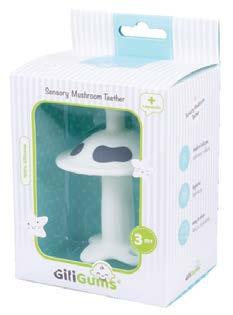
Invest in a choice of superior-quality teething rings. Paediatrician-approved teething remedies include chewing on something cold. Not all teething rings are created equal however and you will need to consider it is made from safe materials, is easy to clean and mould is prevented from growing inside.
BPA-free and suitable for children from 0+, the Infantino Chew and Play Ring Teether is an all-around activity teether which is soft and flexible with an easyto-grab shape, soothing textures and spinning rings and covered soft teeth able areas.
Babies are drawn to bold colours, playful prints, and soft fabrics and the cute and friendly Infantino Cuddly Teether Penguin features unique textures and crinkle sounds baby will love exploring. It encourages sensory development, and along with mobiles and overhead gyms can be helpful in encouraging eye tracking.
The 3-stage Infantino Crystal Clear Teether Set is a lovely gift set for first time parents as they tackle the three stages of teething with BPA, PVC, dye and Phthalate free teether full of textures and shapes needed to meet all stages of teething. These 100% pure teethers cool in the refrigerator providing extra comfort, are easy for small hands to grasp with interesting textures which relieve sore gyms. Most importantly, they are also easy to keep clean.
When no help is at hand, you can massage baby’s gums with a clean finger to relieve the pressure of the tooth pushing through. You can also warm a face cloth or dip it in chamomile tea and give it to your baby to chew on.

Freeze breast milk into ice cubes to distract baby and calm sore gums. You can also give them cool or frozen foods such as carrots, bananas, or apples which are safe for your baby to gnaw or gum on.
Happy Family Organics provides delicious safe snack and a teether with their Happy Baby Teether Sweet Potato and Banana made with jasmine rice flour and a touch of organic fruits and veggies, which dissolve easily, making them a perfect first snack for baby’s developing gums.
The Happy Baby Teether Crackers with strawberry and beet with Amaranthus, is an easily dissolving cracker made with ancient grains and organic fruits and veggies. It is not only tasty for baby, but easy on their gums and encourages self-feeding. All the Happy Family Organics baby products are gluten-free, Kosher, certified organic, contain no GMO or high fructose corn syrup, artificial food colourants or flavourants.

Keep baby comfortable by keeping them dry. Drool creates constant moisture around their hands and face which can cause a wet rash around their mouth, adding to their gum distress. Keep the teether as dry as possible and invest in a durable bib so drool does not soak onto their clothing.
Before trying any over-the-counter remedy or teething gels for your teething baby, check the label and the ingredients with your medical professional advisor first. What was acceptable in the past, may now be advised against including ingredients such as benzocaine, an anaesthetic commonly found in many over-the-counter teething gels.
Following FDA recommendation, parents and caregivers should not use benzocaine products for children younger than two years as it causes a rare, but serious (and occasionally even deadly) condition called methemoglobinemia, in which the oxygen carried through the bloodstream is reduced to dangerous levels.
Old wives’ tales and well-meaning advice can also be risky for your vulnerable child. Do not rub whiskey on your baby’s gums! Alcohol can be potentially toxic to your little one.
There is no evidence that Amber teething necklaces for babies that claim to release a pain-relieving substance when warmed by the baby’s body temperature and absorbed through the skin into the bloodstream. The chance of your child biting the necklace and choking on the beads or being strangled by the necklace while sleeping is a risk.
Night-time teething can be the most disruptive. As you settle baby, distract from the teething pain with the addition of white noise to redirect their attention or a soothing night light with revolving roof reflections or hanging mobiles to soothe and settle them in for sleep.
The Infantino Mobile Musical Projector 3-in-1 ensures your little dreamer can sleep soundly through the night. It features a mirror reflecting a friendly face and an auto shut-off timer after 20 minutes. This nightlight can transform in three ways: as a mobile, a star projector mounted onto the crib, or a bedside projector.





Oral thrush affects about 5% of newborn infants, and bottle-fed infants are at a higher risk of developing infection. It is common from birth until around one year of age. Dr Elewani Mathivha, a Paediatrician practising at Netcare Femina Hospital, gives advice on how to treat this.
Oral thrush is a superficial mucous membrane infection of the oral cavity, which is inside of the mouth. A fungus called Candida albicans is the most common cause of oral thrush. Less commonly, other species like Candida tropicalis have also been implicated.
What does oral thrush look like?
It can be present as a fungal infection of the muscular tube that connects the mouth and the stomach (oesophageal candida) which may cause severe feeding difficulties, as well as a diffuse spread of the fungal infection from the local site in the mouth to the blood (haematogenous spread).
Babies present with white patches or plaques that are adherent to the cheeks, lips, palate, and tongue. With scraping, there may be bleeding points under the plaques. Curdled milk in the mouth is most often confused with candida but the former is easy to scrape off leaving healthy mucosa with no bleeding points.
Parents must consult a doctor when they notice lesions in the mouth, for medical evaluation. Without treatment, infection can spread to the oesophagus causing feeding and swallowing difficulties.
Oral thrush is unlikely to resolve without treatment, however, with treatment, it will usually resolve within two weeks. Candida can spread by direct contact like kissing. It is otherwise not contagious.

• Parents are encouraged to cup-feed bottle-fed infants especially while treating the infection.
• Adequate sterilisation of bottles, pacifiers and teats is critical to reduce the risk of Candida infection.
• Parents must note that malnutrition, immunosuppression and use of antibiotics in the first year of life may predispose babies to infection.
• Recurrent oral thrush with no predisposing factor should be further investigated by a doctor.





Without treatment, tapeworms can reach a whopping 15 metres in the human intestines. This is just one type of common parasitic intestinal worm infection that South African families should be aware of and take routine precautions against.

“Whether or not we like to think about it, intestinal worms are more common than most people realise. These parasites are in the environment all around us looking for hosts, and can easily infect entire households,” says pharmacist Joy Steenkamp of Medipost Pharmacy courier pharmacy.
“The eggs of pinworms are so tiny they can be breathed in, while hookworms in the soil can enter the body through walking barefoot, and tapeworms are often unsuspectingly eaten in undercooked meat or fish. Households with children and pets also face a greater risk of intestinal parasitic worms.”


Although there are often no symptoms, especially in the early stages of infestation, a course of deworming medication is recommended for all members of the household and pets regularly.
“It is recommended that we take the precaution of deworming twice a year. Since intestinal worms spread so quickly, everyone in the home, including the pets, should take a course of deworming medication at the same time to prevent reinfection,” says Steenkamp.
• Hookworms are known as soil-transmitted helminths. These parasitic worms can enter the skin of your feet, and infection can cause painful diarrhoea, and in serious cases may lead to iron-deficiency anaemia and protein deficiency.
• Whipworm and roundworms can be contracted through contaminated soil in contact with your mouth, even if it’s invisible to the eye. Serious, untreated whipworm infections can cause anaemia while serious roundworm infections could lead to fever, coughing and potentially severe vision problems.
• Pinworms affect only humans and are contracted by inhaling or touching contaminated food or objects, including bedding or clothing. Symptoms include itching of the anus that can result in difficulty sleeping and restlessness.
• Tapeworms are members of the flatworm family and can enter the human body by eating infected undercooked fish, beef, or pork, or through the faecal-oral route.
“To prevent infection as far as possible, some helpful hygiene measures include cleaning up pet faeces in bags being careful not to touch it, covering up children’s sand pits when they are not in use, and washing hands frequently, especially after going to the toilet, handling pets, and before eating and preparing food,” Steenkamp advises.
“It is also important to wash fruit and vegetables and cook food thoroughly. Washing household items frequently, including washing bedding in hot water, can also kill the organisms and help prevent intestinal worms from spreading in the home.”
Home treatment
“Thankfully, there are treatment options available without a prescription. It is important to pay attention to the package insert warnings, as this medication is not for pregnant women or children under one year old,” Steenkamps adds.
Most intestinal worm infections can be treated with a single dose or twice daily three-day course of mebendazole, available from pharmacies including www.shop.medipost.co.za. Sold under various brand names, it comes in tablet form or suspension. If needed, the tablets can be crushed and swallowed with liquid.
Self-medication products purchased from Medipost Pharmacy are delivered safely, discreetly, and conveniently to any address in South Africa. Delivery is free when combined with the delivery of chronic medicines.
“Side effects are uncommon with short-term treatment for intestinal worms. Very little of the medicine is absorbed beyond the gastrointestinal tract, as this medicine works through contact with the intestines where the parasitic worms are most likely to be before it is eliminated by the body. Occasionally, however, people may experience an upset stomach, especially with severe infections,” Steenkamp notes.
People with sensitivities and allergies to common inactive ingredients should double check with their pharmacist and the medication label for ingredients, such as sucrose or sweeteners among others, and discuss any potential cause for concern with their doctor.
“Anyone can be affected by intestinal parasites, don’t wait for the signs of infection. Look after your family with regular preventative deworming as part of your annual health and hygiene routine,” Steenkamp concludes.
It is more common in older infants and young children. The peak age of presentation of impetigo is from two to six years of age. It is less common in babies younger than six months.
Symptoms of impetigo
It can affect any part of the body but most often starts in the nostrils and then often spreads to the face. It usually starts as a superficial blister which later erodes the skin, becoming deeper round moist blisters that rupture leaving yellowish crusts around the edges.

The blisters may result from tiny vesicles or form large pocket-like fluid-filled lesions called bullae. It is usually not painful, and it is not associated with fever. It may, however, be itchy.
Symptoms usually last for seven to 10 days.
Conditions that may be confused with impetigo include the following:
• Ringworm (Tinea corporis)
• Burns
• Viral infections like chickenpox or shingles (varicella zoster) and Herpes simplex
• Scabies
Highly contagious
Impetigo is highly contagious. It is spread by skin-to-skin contact like hugs, kisses, and handshakes.

A doctor should be consulted if you suspect impetigo. Treatment is usually with oral antibiotics and babies and children affected can in most cases be successfully treated at home. Only complicated cases may require intravenous antibiotics.
Parents should seek medical help again if the lesions don’t resolve after an antibiotic therapy course or if they notice systemic complications like fever, swollen lymph nodes, swelling of surrounding tissue (cellulitis), cough and fast breathing (usually a sign of pneumonia).
Impetigo is seldom a serious infection and complications are very rare. Lesions usually resolve completely with no scar formation and full resolution of the infection is usually attained.
RELIEVES STIFF & PAINFUL JOINTS





BENEFICIAL TO THE CARDIOVASCULAR SYSTEM AND HIGH BLOOD PRESSURE IMPROVES THE IMMUNE SYSTEM








BENEFICIAL FOR DIABETICS
IMPROVES BLOOD CIRCULATION


IMPROVES SKIN ELASTICITY







BOOSTS IMMUNE FUNCTION

IMPROVES MOOD & CONCENTRATION








































REDUCES ADD SYMPTOMS

IMPROVES BRAIN MESSAGING FUNCTION
ENCOURAGES HEALTHY SLEEP PATTERNS


FOR MORE INFORMATION
CONTACT: 042 293 1278


E-MAIL: valuedlife@epweb.co.za








Is your child smart at everything but school? Does your child avoid reading? Does your child not understand what they read? Does your child struggle with homework?
 By Dharmendra J. Bhoola
By Dharmendra J. Bhoola
Vision is a learnt skill just like walking and talking. When vision works well it guides and leads, and when it doesn’t it interferes with your child’s learning abilities.
Children who lack basic visual skills have a difficult time in school. They enjoy being read to and will sit and listen, but when they use their eyes for reading and homework they cannot concentrate and may display symptoms of ADD/ADHD. Current research in the US indicates that approximately one out of four children and seven out of 10 juvenile delinquents have had vision problems that have interfered with their ability to achieve their full academic potential.
Vision is a complex process involving many visual skills that utilises more than 65% of all pathways to the brain. These skills include:
• eye movement control
• focussing far to near
• sustaining clear focus
• eye teaming ability
• depth perception
• eye hand coordination
• visual form perception
• visual memory
Deficiencies in any one or more than one of these skills could be masquerading as ADHD. Vision therapy is used to train all of these skills.
The best know visual ability is 20/20 eyesight. Unfortunately, 20/20 eyesight with or without glasses does not mean that during learning a child can see clearly for more than a few minutes. It also does not mean that your child has depth perception and localisation skills to drive at night or that the child is free from vision-related headaches. All 20/20 means is that your child can call out six small letters on a doctor’s chart.
Therefore, in addition to 20/20 vision we need to assess several key visual abilities that are ignored during most eye exams.
Each eye has six sets of muscles, just like many parts of the body. The brain must coordinate these muscles so your child can see comfortably and efficiently. Both eyes need to work together even under stressful situations.
If this coordination is difficult or even off a little bit, eyesight may be clear at times and blurred or double at times. Your child’s unconscious efforts to prevent blurred or double vision can cause premature fatigue, or loss of attention and comprehension during reading and learning. Some eye muscle coordination problems can also reduce depth perception for driving and sports. Poor eye muscle coordination can even cause cross-eye or lazy eye.
This is the ability of the two eyes to align and team together to enable a child to judge his or her orientation in space and have depth perception. A student experiencing eye-teaming difficulties will often cover one of his eyes, blink frequently, exhibit poor desk posture, tire easily when reading and take extended periods of time to complete homework.

This is the ability to make the eyes look quickly from near to far and back again without momentary blur conscious effort or discomfort. A student experiencing a near-to-far focussing difficulty will get frustrated and have trouble copying from a book, and even greater difficulty copying from the board.
Visual tracking refers to how quickly and accurately we move our eyes across a line of print, look at the symbols (such as numbers, letters or words), so we can remember what to call them, and get the sound out of our mouths.
Problems with peripheral vision – seeing people and objects “out of the corner of the eye” – can reduce peak performance. During reading, children with poor visual tracking lose their place, confuse one word with another, make careless errors, and have difficulty breaking words into their parts, Prediction plays a significant role in vision. Peripheral vision greatly influences prediction.
We control our eyes when we maintain eye contact during conversations or keep our eyes on the ball during a rugby or soccer game. When our eye control is inaccurate, vision becomes inaccurate.
It is important to be able to not just get the words clear on a page but also to “keep” the words clear while reading and to change focus quickly and accurately from one distance to another, like changing focus from the book to the board and vice versa.
Our eyes guide or coordinate our hands and bodies. Eye-hand coordination can be “little” or “big”. We need “little” (fine motor) eye hand coordination to copy sentences and to keep words equally spaced on the line. We need “big” (gross motor) coordination to throw or catch a ball. “Big” coordination is also important for balance and general coordination.8
Visual perception is the ability to see how things are alike and how they are different, and how pieces fit together to make up a whole. An example is the child who can’t see the difference between “b” and “d”, or words “was” and “saw”. Poor visual perception can make it difficult to recognise words, complete puzzles, do high level math such as geometry and calculus or align columns in mathematics.
Visualisation is sometimes called “seeing with the mind’s eye”. This means that children should “see” words in their minds to spell them and should be able to picture to “see” or imagine a story when they are reading.
They can picture their goals in their minds, and the consequences of their actions. Visualisation allows children to learn from the past and plan for the future. Children with poor visualisation skills are often poor spellers and have difficulty with math problems when they are different than the studied example. They are often poor “goal-setters” and have a poor self concept.
8
8
25% of children have vision issues impacting learning
Children with vision problems can be misdiagnosed with ADD/ADHD because they:
• skip and reread lines;
• have poor reading comprehension;
• take a longer time to do homework; and
• show short attention span when reading and writing.
According to EYE Centre for Children’s Vision, Learning and Technology, 25% of children have vision issues impacting learning. For one million kids that is 250 000 children in need.
• About 90 000 children need eye glasses for near sightedness (myopia). Distance and near vision screening will detect these children.
• About 130 000 children need eye glasses to correct far sightedness (hyperopia). Distance and near vision
screening will not detect most of the children as risk of this condition.
• 20 0000 have amblyopia (lazy eye). Distance and near vision screening will detect these children at risk.
• 30 000 children have strabismus or an eye turn, distance and near vision screening will miss most of these children at risk of this condition.
• 50 000 have binocular/eye focusing instability like convergence insufficiency. Distance and near vision screening will miss most of the children at risk of this condition.
62 www.babysandbeyond.co.za
medications. Or they are put into special education classes with special accommodations, or eventually even drop out of school altogether and never reach their potential.
In a study published in 2005 in the medical journal, Strabismus by David Granet, a Paediatric Ophthalmologist at the University of California, San Diego, children with the vision problem Convergence Insufficiency (CI) are three times more likely to be diagnosed with ADHD than children without the disorder.
Convergence Insufficiency is a common eye muscle coordination problem. When doing close work, a person’s eyes must turn in (converge) for the words to appear single. This usually happens without thinking. In CI, the eyes do not turn in as easily and as a result extra convergence effort must be used to force the eyes in.
This additional effort can cause a number of symptoms such as eye strain, headaches, blurred vision, double vision, difficulty concentrating, loss of place and concentration as well as reading slowly. CI has no obvious signs and is only detected through a comprehensive visual examination evaluating all the critical visual skills discussed above.
Virtually all people who have CI have 20/20 vision. However, it is not enough
to have 20/20 vision and be able to see clearly. For the visual system to function properly, we must have binocular vision.
There are many types of eye teaming or binocular vision problems. The eyes may tend to drift in, out, up, down, or a combination of these variations, the most common eye teaming problem is CI in which the eyes tend to drift outward when reading or engaged in any near visual activity.
Data gathered by The Convergence Insufficiency Treatment Trail Investigation Group recently in a series of studies, showed that performance based symptoms, loss of concentration, re-reading the same line, reading slowly, trouble remembering what was read or feeling sleepy occurred more frequently than eye-related symptoms i.e. blur, headache, diplopia (double vision) or asthenopia (eye fatigue).
Potential link between CI and attention disorders has practical implications
This potential link between CI and attention disorders has practical implications for educators, physicians, psychologists and other professionals involved in the detection, diagnosis and treatment of attention deficit hyperactivity disorder.
Since a child sees similarly to adults by the age of three, the American Optometric Association, recommends a comprehensive eye examination on an
infant before one year of age. Further, in The United States, comprehensive visual examinations assessing all the critical visual skills required to read and learn are mandatory prior to a child starting Grade 1.
This comprehensive visual evaluation should take at least 90 minutes.
Convergence Insufficiency is a common vision problem in school ages children. Children with this problem may experience numerous symptoms that would make it more difficult to read and learn.
Research has shown that office based vision therapy by a Developmental Behavioural Optometrist can effectively treat the condition with most patients learning to control their muscles and overcoming the disorder in 6 -8 months.
Dharmendra J. Bhoola has a behavioural optometry practice in the Kingfisher Shopping Centre in Fourways. The practice offers specialised services in visually related learning problems and ADHD, Binocular Vision (Eye Teaming) problems, Sports Vision, Neuro Optometric Rehabilitation, Concussions, Vertigo and TBI (Traumatic Brain Injuries) in addition to primary care optometry. He can be reached at +27 (0)11 705 1619, or email at djbhoolaoptometrist@yahoo.com
The five most common signs that a vision problem may be interfering with your child’s ability to read and learn are:
3 2 1
homework takes much longer than it should
4
reverses letters like “b” and “d”
5
short attention span with reading and schoolwork
As every parent knows, raising a family is challenging even at the best of times. Those experiencing a change in their living situation due to a split between parents or the forming of a new, blended family are faced with an entirely more difficult reality.

Dr Terri Henderson, a child psychiatrist practising at Netcare Akeso Kenilworth, says that for children to experience well-rounded development, they need to be in a family structure with strong role models.
“Childhood development happens in stages and major traumas, such as divorce, can interfere with that development. This however does not have to be the case if handled correctly from the outset,” she says.

Dr Henderson notes that from a child’s perspective, the central theme during any change in family structure is lost, with worries around questions they may not openly express, such as ‘What is going to happen to me? What will happen to my mom or dad? When will I get to see them? When will I get to see my pets? How will I get to school?’, for example.
“Adjusting to new living arrangements can have some behavioural and emotional consequences. Children and teens may seem less interested or enthusiastic about their normal, familiar activities. This may look like withdrawal from play activities, friendships, school, sports and hobbies. Children may show their distress through physical complaints such as tummy aches or repeatedly saying they feel sick. If any of these behaviours persist this may be cause for concern and professional help should be sought.
“Furthermore, if your child sees that you are also accessing professional help this can go a long way to alleviating some of their concerns, as they will worry less about you, provided that you discuss this at their level and explain that it is ok to ask for help,” she says.
“When forming a blended family it is highly advisable to make time for counselling regarding the new relationship to assist you in navigating important areas, such as the needs of your new partner’s children, how to manage things with your partner’s ex, what the parenting rules and roles are going to be, and so on. It is essential to do this foundational work so that you can embark on the new journey as a unified front in a relationship that will stand the test of time.
“Prioritising the relationship over what the children need is a mistake – the new relationship is more likely to survive if the kids feel cared for and are adjusting well to a new family life,” Dr Henderson cautions.
Mark de la Rey, a clinical psychologist practising at Netcare Akeso Kenilworth, points out that new partners in a blended family should be mindful that children may behave in a hostile or offish manner because of the hurt and insecurities they may have carried over from the breakup of their original family.
“This in turn may spill out into the new relationship. For this reason, family counselling that also includes the children, in addition to counselling for the new couple, can be highly beneficial,” he says.
De la Rey advises that in cases where a child is living between two homes and potentially sharing a space with a stepsibling, they should bring some personal items to leave there in a secure place.
“It would help to buy them their own individual duvet cover, pillow slip, and other soft furnishings that give them a sense of place and ownership. It is also important to think about matters such as where they can change in privacy.”
Dr Henderson adds that providing children with their own space and belongings in a second home makes them feel like somebody has thought about them.
“It is important to show your children that you have them in mind – something as simple as always keeping their favourite cereal in the house can be reassuring.
“It can also be useful to make the household routine and rules visible by putting everyone’s schedule up in the kitchen as well as a roster for household chores – this adds a more tangible element to life in their new environment and helps to put them at ease,” she says.
“Communication upfront is of the utmost importance in preparing your child for the change that is about to take place. This can be difficult when you are dealing with your own concerns, but it is a crucial stage in the process of mentally preparing your child for living between two homes or blending with another family.
“What you say and how you say it must be pitched at the age-appropriate level. Explain the essence of the situation calmly and clearly, with the focus being on your child’s experience. The most important and protective message to keep getting across is this: Our family structure is going to be different, but we are thinking about you constantly in our planning, and we will try our best as parents to work together to make sure you have what you need.

“In a change of family structure, routine is your number one lifejacket. Providing a framework through routine, especially across two different homes but also within a single home, helps to make children feel secure. It is the details that matter here – the time you wake them, leave to go to school, serve dinner, put them to bed as well as keeping to the weekly schedule of extramural activities, visits with grandparents and so on.
“Your other two lifejackets are consistency and predictability. If you consistently phone them at say 6pm every evening that will do wonders. If you see them every second Saturday, for example, without fail, that will go a long way. This says: I am going to make time for you no matter what because you matter to me,” says Dr Henderson.
“If you are inconsistent on the other hand, what you are telling your child is that they are not worthy enough for you to make the effort to be there for them. You can still parent effectively over separate spaces by agreeing to do what’s best for the children and following through.”
Laying down certain boundaries before moving forward together as a blended family is essential, according to Dr Henderson, as this helps to set expectations and manage inevitable moments of conflict in which children may try to play one partner off against the other.
“Making quality time to connect with your children outside of the blended family is the cornerstone of maintaining a good relationship. Here, they are able to access you in their own way and in their own time. Make a standing weekly date with them and stick to it, so they don’t get lost in the blended environment.
Take a collaborative approach
De la Rey notes that including children in planning their visits or contributing to certain aspects of the new home can make them feel seen. “If you are discussing an upcoming visit or special family time together, ask them what they would like to do. As far as possible, involve them in even some of the more mundane aspects of being part of the family, as this will give them a sense of belonging,” he says.
“When children are feeling uncertain, they will push a boundary. If the boundaries are reasonable, and you are all on the same page, you should be able to work together as a family successfully,” she advises.
“Boundaries for teenagers are more likely to work if you set them together – this helps to create an environment that is acceptable to everyone. However, you as the parent will still have to make some tough decisions.
If your child does not live in your blended family on a permanent basis, you have to make time to be available to them, not only when they visit you but also while they are living away from you, in order to stay connected, otherwise the other children will get all of your parenting presence. Ultimately, quality time with your child lets them know that you are there for them, it lets you know where they are mentally, and it keeps you connected,” concludes Dr Henderson.
In the event of a psychological crisis, call 0861 435 787, 24 hours a day for emergency support. Psychiatrist consultations can be made through Netcare appointmed™, online at www.netcareappointmed.co.za or by calling 0861 555 565. Outpatient psychologist and occupational therapist consultations can be booked via www.copetherapy.co.za.

Your other two lifejackets are consistency and predictability.




Emotional regulation refers to a child's ability to manage their emotions in a socially acceptable way, including the ability to delay immediate responses or use alternative responses. But many parents and educators aren’t readily able to identify whether a child’s behaviour is in line with expected development milestones, or whether they have specific needs related to emotional regulation which require additional support.
“Emotional regulation is the ability to respond to a range of emotions in a socially acceptable or tolerable way. This would include spontaneous reactions and the delay of an immediate response, or the use of an alternative response,” says Dr Greg Pienaar, renowned Educational Psychologist and Principal of The Bridge Assisted Learning School, which supports students facing challenges unrelated to cognitive ability.

Challenges related to emotional regulation are becoming increasingly common among children in today's society.
He says emotional regulation is a critical aspect of a child's overall development, and that unresolved and unsupported difficulties in this area may have a negative impact on the child’s academic, social, and emotional functioning.


“It is therefore important that parents who have concerns are able to identify whether their child needs additional help, so that they can receive the necessary support and interventions to promote healthy development,” he says.
Dr Pienaar says parents can assist struggling children to cope with emotional dysregulation by providing routine and structure at home, ensuring consistency, providing clear expectations and boundaries, and also by providing safe spaces for regulation.
Should these early interventions not have an impact, professional help should be sought, which may include regular therapy where a child learns alternative approaches, and potentially prescribed medication.
• Not wanting to attend school at all, for instance if a child routinely cries when it’s time to go to school.
• Being generally emotionally unhappy, where the unhappiness can’t be connected to a concrete issue.
• Losing interest in everyday activities which would have interested the child before.
• Acting out, by displaying negative behaviour which wasn’t in place before.
• Extreme anxiety (or possibly generalised anxiety) in other areas of the life of a child where there may not have been anxiety before.
• Becoming frustrated when a calmer, more reasoned approach would have been in place before.
• Becoming more sensitive to sensory stimuli.
• Struggling with separation anxiety.
Emotional regulation is the ability to respond to a range of emotions in a socially acceptable or tolerable way.

One of the main sustainable interventions which will help children through their dysregulation journey is to ensure they are in the right educational environment, where they can enjoy the support of qualified, knowledgeable and experienced professionals who understand their challenges and where they won’t merely be sidelined in the classroom because of challenging behaviour.

“A smaller cottage-style school may be more appropriate, but ideally a specialised environment geared specifically to assist neurodiverse children with unique emotional needs should be sought. Educators and staff in these schools have specialised training and experience which enable them to understand and assist students struggling with emotional dysregulation,” says Dr Pienaar.
“Very importantly, these schools are able to provide the kind of structure and routine, and indeed predictability, which help reduce anxiety and enables children to develop positive emotional regulation skills. Therapy, counselling and other professional support services are often included as part of the school’s programme, which means that regular scheduled professional support is provided for the child.”
Dr Pienaar says that parents often feel overwhelmed and out of their depth when their child struggles with emotional dysregulation. But he adds that if the matter is identified and support sought for the child as soon as possible, the prognosis for the child’s emotional, personal and academic development is very good.
“Early intervention can help children develop the skills they need to manage their emotions effectively and improve their overall functioning. Research has shown that effective interventions, such as behavioural therapy, can significantly improve emotional regulation skills in children.
“With appropriate interventions, children can learn to recognise and manage their emotions, understand and express their feelings in a socially appropriate way, and develop positive coping skills, while reducing the likelihood of more significant mental health issues developing in future,” he adds.
References:






Daily stress and the fast pace of life can entice us into habitually eating more than our bodies need, often without being fully aware of it, with harmful implications for our physical and mental health, writes
 Dr Louise Chalmers, Specialist Family Physician practising at Netcare Akeso Randburg,
Dr Louise Chalmers, Specialist Family Physician practising at Netcare Akeso Randburg,
Crescent
Clinic. By Dr Louise Chalmers, NetcareAkesoRandburg, CrescentClinic
It is so easy to develop an abnormal relationship with food. We cannot live without it. Mood and food are inseparable in the sense that what happens at cellular level impacts how we feel and function. When a person has very unstable sugar levels this stimulates the production of stress hormones. You may have noticed that when your blood sugar is low, you may feel edgy or tense and eating something that is loaded with fat and sugar is a quick fix that makes you feel ‘better’.
Often unhealthy choices creep in out of convenience, and very quickly these can become part of our habits or routine. Many people who live with food addiction and obesity may eat healthy meals but tend to also constantly ‘graze’ throughout the day, far exceeding the recommended calorie intake without necessarily realising how much they are consuming daily.

This may start gradually, perhaps having a smoothie on your way to work after eating breakfast at home, or coffee and a doughnut when you are having a stressful morning. After lunch, do you perhaps feel you ‘deserve’ a chocolate for working so hard, and maybe a drink and a packet of chips as you’re driving home? It all adds up, and before you know it, you can find yourself trapped in a pattern of overeating and its consequences.
Food makes us feel ‘happy’, albeit a temporary and superficial sense of contentment. Our relationship with food starts when we are very young, and it is especially important for parents and schools to consider their influential role in the development of healthy patterns in children and young adults.
Of course, it is easier to feed kids fish fingers and chips, typically with calorie-laden mayonnaise and tomato sauce, than a healthy freshly prepared balanced meal. As an occasional treat these ‘easy’ meals are fine, however giving in to food cravings to make us or our children ‘happy’ on a regular basis risks establishing a dangerous precedent in how our families relate to food and may eventually come to emotionally rely on it.
Many tuckshops sell caffeine and sugar laden energy drinks nowadays. Not only is this normalising the idea of using chemicals to get through the day, the buzz of caffeine and appetite suppressant effects can even become a gateway to more serious addictions in future.
Food is a cornerstone of our lives, and this makes it especially difficult for people with food addictions. It is not possible to stop eating, like one can permanently stop drinking alcohol or avoid drugs –food is a necessary part of life and is also an important focus of many social occasions. Instead, those who struggle with compulsive eating must learn how to redefine their relationship with food and this is often more successfully achieved with inpatient treatment.
All forms of an eating disorder benefit from a multidisciplinary team approach to treatment, and at Netcare Akeso Randburg Crescent Clinic, in addition to me as a family physician, a dietician, occupational therapist, psychologist and psychiatrist, if needed, all contribute to helping the person reclaim their life.
No one ever sets out to become addicted, whether to food or any other form of addiction. It is possible to break unhealthy habits before they become so deeply ingrained, and this starts with simply being aware. Keep a food diary, noting portions of everything that passes your lips including water, how many cups of tea and coffee and how many sugars in each, and all snacks between meals.
It is important to be honest with yourself and recognise if your relationship with food has spiralled out of control, however, don’t be too hard on yourself. If you notice you are overeating, seeing it written down can help to empower you to make small changes that can make a huge difference to your wellbeing and long-term health.
Food addiction is nothing to be ashamed of, as addictions develop in response to circumstances but there are ways to overcome these harmful habits. Practise self-compassion, as shame and guilt can often lead to a person hiding their inner pain rather than seeking professional help when it is needed.

Leading a healthy lifestyle not only impacts our physical health but also our mental health, and part of that sense of well-being is feeling comfortable and happy with our body aesthetically too. Whilst there are a number of things each of us need to do in order to look and feel our best, many people; women, men and younger patients too in extreme cases; are turning to body sculpting to help them achieve their desired look.
By Dr Nombulelo Metuse, Plastic & Reconstructive SurgeonBody sculpting, or body contouring, is a cosmetic procedure that reshapes or alters the appearance of a person’s body and can be used to target areas of fat, skin, or muscle that are unresponsive to diet and exercise. In some cases it can be used for those who have worked really hard to lose surplus weight but are left with the aftereffects of a massive physical change which can include things like excess skin.
As a plastic surgeon, I believe that body sculpting can be incredibly beneficial for individuals eager to improve their appearance. Through body sculpting, the goal is to help patients achieve the body they have always wanted with procedures that can be tailored to their specific goals and needs.
In addition to the aesthetic benefits of body sculpting, there are numerous health benefits as well. When conducted correctly, body sculpting can help improve posture, reduce back pain, and even enhance athletic performance.

Massive weight loss is an incredible accomplishment that requires immense commitment and dedication. However, the journey is often incomplete without plastic surgery to minimise the sometimes-unavoidable physical after-effects.
Individuals who have lost a significant amount of weight may experience loose skin, residual fat, and other issues that require additional medical intervention. Plastic surgery can assist in alleviating these issues and help individuals who have successfully lost weight feel more confident in their appearance.
The massive weight loss journey is a long one and can involve multiple surgeries but to safeguard the patient’s health and mental well-being, each patient must undergo an in-depth assessment which addresses each individual’s particular set of needs and circumstances.
When meeting with a patient for the first time it is important to assess the psychological aspect as I believe you must treat the root of the problem before performing surgery. For example, if overeating or comfort eating is
the cause of weight gain, we must first address why the patient is self-medicating with food. It would be irresponsible to perform body sculpting surgery if there was a high possibility of the patient regaining all the excess weight again after body sculpting surgery because the proper psychological assessments and therapies were not carried out.
In some cases, when a patient has lost weight and undergone body sculpting surgery, it can cause tension in their relationship because their partner is insecure about their new way of dressing and drastically changed appearance which can attract a lot of positive attention.
It is vital that patients work on getting rid of unwanted body weight before surgery and fortunately there are plenty of options to help achieve massive weight loss before undertaking a procedure.
The healthiest and most effective option is a combination of diet and exercise. By following a diet of healthy food choices and committing to regular physical activity, you can burn fat, build muscle, and start to see real results. There are countless nutrition plans and exercise regimes to choose from, so it’s important to find one that works for you and your lifestyle that will be sustainable.
Another option for clinically obese patients is a medical weight loss programme. These programmes are often supervised by a medical professional or nutritionist who can provide an individualised eating and exercise plan that takes into account the patient’s lifestyle, medical history, and other factors. This can include dietary counselling, prescription medications, and other treatments to help them reach their weight loss goals.

If a more extreme course of action is required, bariatric surgery could be a solution. This type of surgery can help a patient lose a significant amount of weight quickly, but it’s important to understand the risks and potential complications associated with the procedure. Post bariatric cosmetic surgery is not a substitute for healthy lifestyle habits, such as a balanced diet and regular exercise.
Bariatric surgery is designed to help people who are severely overweight or obese. It involves reducing the size of the stomach and intestines, and sometimes, bypassing part of the small intestine. This helps people to eat less and absorb fewer calories, leading to weight loss. Bariatric surgery can also help reduce the risk of developing certain health conditions such as type 2 diabetes, high blood pressure and heart disease.
Post bariatric cosmetic surgery can help to improve body shape and contour, and also boost self-confidence. It can also help to reduce skin sagging, which is a common side effect of weight loss and can include facial procedures such as neck lifts or eyelid lifts.
Overall, bariatric surgery and post bariatric cosmetic surgery can be a great way to improve your health and physical appearance. If you are considering this type of surgery, it is important to discuss your options with a qualified and experienced plastic surgeon.
Body sculpting can also be useful in addressing issues that are not directly related to diet, for instance, many people suffer from excess skin following pregnancy. For the most part, body sculpting can be used to improve the patient’s overall appearance through various procedures liposuction which will alleviate cellulite, lift breasts or thighs and reduce sagging underarm skin, also known as “bat wings”.

Loose skin can occur as a result of extreme weight loss, and it can be particularly bothersome due to its visibility. Loose skin can be removed through a variety of methods, such as abdominoplasty (tummy tuck),
brachioplasty (arm lift), and thigh lift. The procedure will vary depending on the individual and their needs.

Minimally invasive and non-invasion surgical equipment can be used to address cellulite after massive weight loss.

After weight loss, the breasts and thighs may hang lower than previously due to the loss of body fat. These procedures are designed to restore sagging breasts and reshape the thighs by reducing excess skin, and in some cases fat, resulting in smoother skin and better-proportioned contours.
Fields of interest: Abdominoplasty, acute and chronic injuries, blepharoplasty, breast augmentation, breast lift, breast reconstruction, breast reconstructive surgery, breast reduction, browlift, cleft lip & palate, cysts, eyelid surgery, facelift surgery, facial aesthetic surgery, keloids, liposuction, mommy makeover, nasal reconstruction, otoplasty, scar revision surgery, tummy tuck, tumours.
Qualifications: MMED Plastic Surgery (UP), FC Plast Surg (SA), MBChB (Medunsa)
With rooms in the @Sandton Lifestyle Hotel Medical & Surgical Suites, patients have the option of checking into the hotel for the duration of their recuperation. By doing so, they may take advantage of the hotel's amenities, which results in a distinctive fusion of wellness, holistic relaxation, and aesthetic beauty.



 By Dr Judey Pretorius, Biomedical Emporium
By Dr Judey Pretorius, Biomedical Emporium
Many people think that you only need to apply SPF during the warmer months, and that it’s only really necessary when spending prolonged time outdoors. The truth is that you should apply SPF every day, regardless of the season.
UVA rays (the rays that cause the skin to burn) may not be that strong during the colder months, but UVB rays (the rays that cause hyperpigmentation, wrinkles and fine lines) are present all year round and pose risks to your skin at any given time. UV rays can penetrate clouds, meaning your skin is at risk even on an overcast day.
We have access to a wealth of skincare information, but despite the vast amount of knowledge out there, there are still a lot of skincare myths that are commonly believed to be true.
You don’t need retinol until your later years


Retinol (Vitamin A) is the holy grail of skincare ingredients. This powerful ingredient has the ability to increase the skin’s collagen production, increase the rate at which the skin’s cells turn over, treat and prevent acne, blackheads and breakouts and minimise fine lines and wrinkles.
The saying “prevention is better than cure” rings true – delaying the onset of wrinkles and other signs of ageing is much easier than minimising existing ones. It is ideal to introduce retinol to your regime in your mid-20s to delay the formation of fine lines and wrinkles.
Try Biomedical Emporium Retinol Serum. It reduces hyperpigmentation, soothes and protects skin cells against solar damage, slows down the destruction of skin proteins, builds new proteins, improves DNA health and protects against UV radiation assisting in the reduction of the signs of ageing.
Makeup itself does not cause skin to age faster
– in fact a lot of modern foundation formulas contain anti-ageing ingredients to complement your skincare regime. The only time that makeup may contribute to the ageing process is if you do not remove it properly or go to bed wearing it.
When you go to sleep without removing your makeup, it’s not just the makeup that stays on your skin – it’s also dirt, impurities and bacteria picked up during the day, and these have the ability to accelerate the ageing process.
We recommend a “double cleanse” at night to ensure all makeup is removed. Begin your routine by removing your makeup with a good quality makeup remover like Biomedical Emporium MakeUp Remover. Once your makeup is removed, cleanse your skin with a deep cleansing cleanser like Biomedical Emporium Facial Cleanser, which deeply cleanses and gently removes impurities without disturbing the barrier integrity of the skin.
When it comes to exfoliation, it is crucial to be gentle. If you’re exfoliating with a physical scrub, err on the side of caution and gently massage the product into the skin, in circular motions. Rubbing or scrubbing too hard will actually damage the skin. Plus, if you exfoliate too often you could strip the skin of its natural moisture. Less is more.

We recommend using an enzymatic exfoliator once or twice per week. This is an enzymatic type of exfoliator that does not contain physical exfoliating beads and is thus a safer option. Try Biomedical Emporium Enzymatic Therapy. This enzymatic exfoliator assists with the removal of dead skin cells without causing any harm or discomfort to the skin.
... delaying the onset of wrinkles and other signs of ageing is much easier than minimising existing ones.
While it’s true that steam helps open pores, you should never wash your face with hot water. Hot water might feel good, but it can damage skin by stripping it of its natural oils, drying it out and damaging its protective barrier. Lukewarm water is ideal.
Not sure if the water is too warm? If your skin is red or flushed after rinsing, the water was too hot.

Dr Judey Pretorius
Oily skin doesn’t need to be moisturised moisturising in an attempt to control your skin’s oil production. The truth is that even oily skin requires moisturisation.
If your skin is oily you may be tempted to avoid
Select a non-comedogenic moisturiser with a light texture that doesn’t feel heavy on the skin. A hyaluronic acid moisturiser is a great option for all skin types as it is naturally found in the body and helps the skin retain water, keeping it hydrated.
Dr Judey Pretorius is a highly accomplished biomedical scientist and product development specialist with substantial experience in the disciplines of acute, chronic and post-surgical wound healing, regenerative medicine and cell therapy. Her qualifications include: Master’s degree in Genetics and Molecular Biology; PhD degree in Pharmaceutical Chemistry, Medicine Development and Design; and an Advanced Diploma in Dermal Aesthetics.
Additionally, Dr Pretorius is the co-founder of Biomedical Emporium®, a biotechnology company specialising in the formulation of advanced biological products, cell culture processes and tissue engineering for advanced wound healing and an advisory on regenerative medicine.
www.biomedicalemporium.com
The truth is that even oily skin requires moisturisation.

As like in everything else in the world, you get what you pay for. Cheap is not always cheerful, nor the most effective. The best process to drastically reduce the ageing process lies in science but this takes time and patience.
Dr Sheryl Smithies, a top Cape Town based aesthetic dental surgeon and facial aesthetic specialist, shares her five long lasting tips to aesthetically refresh your look for 2023, and how to drop five years off your face.

It’s no secret that aging is inevitable but most of us want to try and put it off for as long as possible. The market is flooded with pills, creams and new technologies that claim to be the fountain of youth but most of these lotions and potions seem to be just cheap marketing gimmicks...
Today’s fast-paced world is demanding on our bodies, so it is imperative that we take the time to work on us, refuelling our energy tank but also conditioning our body and soul. Your body is the only home you have, so you need to nourish and maintain it, but this takes time. Sadly, there are no quick fixes.
We all know that our bodies start producing less collagen as we age and this causes our skin to become thinner, drier, and less elastic. Collagen induction treatments have been on the market for some time now, but there are some fantastic new injectable filler options that have become recently available.
These stimulate the body’s own collagen production and build support for your skin, helping it stay tight and not droop as much. Again, talk to an anaesthetic therapist and doctor to find out what innovative treatments will be best suited to you and your skin.
By working with an anaesthetic therapist and doctor, you can build a personalised treatment plan to ensure that you are gaining the best out of your treatments and maintaining your skin optimally to create a younger looking you.
A proper plan would span several months, if not an entire year and focus on things like a facial peel and micro needling every other month and regular laser treatments interspersed with specific filler treatments for example. Having a clearly defined plan also helps to spread the costs of treatment.
Threads, or solid fillers as they are often called, are another great way of building collagen and can completely eradicate the small grooves and lines we often see, especially on the forehead and neck area.
Threads are an amazing technology that allow us to be a better version of ourselves while utilising our own natural collagen. The investment is costly, but you are guaranteed that that the treatment will last you at least two years which is a great long-term investment.
Threads can be placed in almost any area of the body but unfortunately, they just don’t work as well in some regions. For these areas, your injectable collagen stimulators take over to ensure a smoother look and feel.
As you age, your teeth undergo some serious chewing work, and this can be exacerbated by grinding or clenching habits. All of this wears the tooth structure away and creates a very worn and tired look around the lips and mouth.
If your teeth look extremely straight and square, you may have worn down a serious amount of tooth structure already. An aesthetic dental surgeon will be able to work with you to build on what you have worn down.
Using advanced Digital Smile Design and 3D scan technology, they will be able to design what you have lost and allow you to create, and test drive a remarkable new smile that looks natural and literally takes years off you. It will also ensure your teeth remain undamaged, instead protecting them from further wear.


As you age, your teeth also start to go askew and, in the past, adults would treat this by subjecting themselves to having braces. Clear Aligner therapy is a revolutionary replacement to braces, allowing you to straighten your teeth in an extremely non- invasive manner that is almost invisible.
This, for me, is the epitome of advanced dentistry. Straight teeth are so important in the aging process. Better positioned teeth help rejuvenate your face and allow for a fuller lip support which improves your entire face and keeps you looking younger. Keeping your teeth healthy, and in your mouth, will also enhance your facial appearance and trim years off your look.
For more insights about how to aesthetically refresh your look, follow Dr Sheryl Smithies @sheryl_smiledr.
Most of us get our formative attitudes about money from our parents and these will generally shape our outlook for the rest of our lives. So, what are the financial fundamentals you should be passing on to your children and when?

AUniversity of Cambridge study, commissioned by the UK’s money advice service, found that by the age of seven most children are capable of grasping the value of money, delaying gratification and understanding that some choices are irreversible and will cause them problems in the future.
A University of London study in 2000 of South African children aged between 7 and 14 bore this out. It found that their views about banking and money were similar to those of children in other countries, although rural children had less understanding than their urban peers.
Earlier children:
The earlier children can start learning about money, the better.
Neven Narayanasamy, at specialist loan provider, DirectAxis and father of two, says the earlier children can start learning about money, the better.
“In doing so it’s best to take a positive, practical reward-based approach by explaining that money is a tool and if they understand how to work with it, it can bring benefits. Don’t stress or scare them and remember every child is different, so you may need to amend your approach and timing.”
Narayanasamy says making your money lessons age-appropriate is also important and suggests the following guidelines.
Age 3-5:
The Rolling Stones were right when they first sang “you can’t always get what you want” in 1969. Fifty-four years on they still are.
We live in an era of instant gratification, from takeaway foods to online shopping. While, hopefully, your three-year old isn’t ordering superhero outfits online during naptime, teaching children early that some things are worth waiting for may prevent them racking up credit card debt on trendy clothes or the latest tech in later life.
If your child wants a particular toy, explain they’ll have to save for it. Have a savings jar or piggy bank into which you can put birthday money or small rewards for helping out, good behaviour or achievements.
Set them up for success by making sure the goal is achievable and that they don’t have to wait months and lose sight of what they are saving for.
Each time your child adds money to the savings, help him or her count it and work out how much more is needed to achieve the goal.
“It’s a good idea to let younger children handle cash under our supervision.Physically handing over money and counting it will make them more confident about handling money and think a little harder about how they spend it,” says Narayanasamy.
Age 6-10:
You can teach the basics of financial decision-making by explaining financial priorities. As an example, tell them that when you get paid you first need to pay bills such as the home loan or rent. Then you need to buy groceries. If you do this carefully and don’t spend money on things that are too expensive or which you don’t really need, you’ll have something left over. You can save some and a bit might be used for doing something fun together.
Practical experience is the best way to drive these lessons home. When they earn pocket money for doing tasks around the house, help them work out a budget.
First, they’ll need to pay bills, such as contributing to a pet’s upkeep. Take them along when you buy groceries, and if they want something special, get them to contribute as part of their grocery spend. Remind them not to spend all their money as they’ll need to save some. Hopefully, if they’ve not spent too much, they’ll have some left to treat themselves.
“The point is to give children a practical understanding of how to manage money using examples that are familiar. The more you can do this the better, as they’re far more likely to grasp this then abstract explanations,” says Narayanasamy.

This is when you can introduce the idea of saving for long-term goals. Perhaps set a goal for something expensive that he or she really wants.
Often in these pre- or early teen years children are reluctant to save because they want to buy things such as snacks at school or more airtime. By setting a bigger goal you can teach them that the opportunity cost – what they need to give up – will enable them to save more and reach their goal faster.

You can also teach them about compound interest: how by saving over a longer period, they benefit from the compounding effect because they earn interest on the money they’ve saved as well as the accumulated interest.
Of course, when saving larger amounts of money, it’s sensible and safer to replace the piggy bank or savings jar with a bank account. Some banks offer under-18 transactional account with no fees, such as FNBy. This will also teach them how to manage a bank account.
Ages 14-18:
As children grow up, their earning potential increases. They may graduate from doing household chores to getting a casual job. Typically, their expenses also increase. They may want to buy a scooter or motorbike to get around, or even save towards a car.
At some point they’ll probably ask to borrow money. When they do, set a goal in terms of what they’ll need to earn before you’ll match them or lend them the remainder.
Work out a reasonable period for the loan and a repayment schedule and charge them a moderate interest rate. Explain there’ll be penalties if they miss repayments and you’ll also be less likely to lend them money in future. While they’ll probably think you’re being a bit harsh, you’re teaching them an invaluable lesson about the benefits of paying what they owe on time and also how to build a good credit record.
As they get older you can use a similar approach to teach them the difference between good and bad credit, such as loans for tertiary studies or starting a business as opposed to borrowing money to fund an unaffordable lifestyle.
As a parent, teaching children about money isn’t something you’ll ever stop doing. Perhaps the most important lesson is to remember you’re a role model.
“If you’ve ever heard a child use a grown-up word or expression they didn’t learn at school, you’ll know they respond to everything they hear or see around them. The same applies to how they learn about money. Remember that and the influence you have not only in terms of what you teach them, but your own financial behaviour,” says Narayanasamy.
For more information about money lessons for children visit: www.directaxis.co.za/make-a-plan/how-to-teach-kids-aboutmoney
You might feel that setting up play dates for your kids is the right thing to do for their social development. However, you might also want to consider the benefits of solo play dates for your child.
One of the biggest advantages of a solo play date is that there is no overstaying your welcome. Your child can spend as much or as little time as they want, without feeling the pressure to keep up with others. This allows them to explore their own interests, and it can also help them develop a sense of independence and creativity.
With solo play dates, kids can engage in activities that they might not have time for during group play. This time can help boost their selfesteem and increase their ability to focus. Also, the days of a crying 'bye-bye' from your little one, are behind you. When your child is playing alone, they don't have to deal with the stress of saying goodbye to friends or dealing with separation anxiety.

Solo play dates can also help children develop problem-solving skills. When left to their own devices, they have to figure out how to entertain themselves and develop creative solutions to challenges they may encounter during play. This type of independent thinking can be valuable later in life.
These play dates can also promote mindfulness and self-awareness. When children are alone with their thoughts and feelings, they can learn to recognise and regulate their emotions. This can help them build resilience and develop a strong sense of self. They can also learn to appreciate the value of quiet time and solitude, which is an important skill in today's fast-paced world.
Snack time and nap time are also easy to manage during solo play dates. When your child is ready for a break, they can take one without interrupting anyone else's playtime. They can snack and rest as they please, without having to worry about sharing or being too loud.
To make solo play dates most enjoyable for your child, you can provide them with a perfect companion like the Fisher-Price Laugh & Learn Smart Stages Puppy and Sis.
This toy is a great source of entertainment, with over 75 songs, sounds, and phrases that will keep your child engaged for hours. They can bring the toy along on their solo play date, making it even more exciting and fun as they laugh and learn.

Dr Wayne Jones, a Paediatrician practising at Netcare Greenacres Hospital in Gqeberha, suggests that parents will see the most effective results by keeping it simple and consistent with basic healthy habits and staying emotionally connected with their kids.
Recognise the full picture of daily nutrition
“The importance of good nutrition cannot be overemphasised in maintaining adequate energy levels and ensuring that your child’s physical as well as mental development remains on track. Many children start the day with cereal, snack on processed foods at lunch break and eat mostly carbohydrates at night,” says Dr Jones.
“This paints a picture where the child is regularly experiencing energy highs and lows during the day, making it difficult for them to sustain concentration. Furthermore, this type of diet can lead to severe constipation, iron deficiencies and being overweight as well as feeling tired and miserable on an ongoing basis, which impacts their school and social lives.”


With the school term in full swing, many parents may be contemplating how best to support the physical and mental development of their children to help them maintain momentum in the year ahead.

• Use the plate model to help you visualise – half the plate is taken up by fresh fruit and veg, one quarter is taken up by whole grains, and one quarter by lean protein, such as chicken or fish.
• Keep it colourful on the plate – lots of colourful, natural foods mean a good mix of nutrients.
• Replace sweetened spreads and jams with unsweetened nut butters, dried fruit with fresh fruit, and swap fruit juices and flavoured waters with natural water.
• Monitor milk intake – one or two cups per day is good for the health, but more than this can begin to impact appetite and water intake, affecting their nutrition and hydration.
• Stick to low GI foods – especially for children who are not big eaters. Nuts, apples, raw carrot sticks and plain yoghurt are good examples of snacks that will provide energy throughout the day.
“It is no secret that children thrive on routine, and this is especially important when it comes to four things in particular – sleep, screen time, physical activity and family time. These aspects of a child’s life are all interrelated and it is important to get the balance right,” says Dr Jones.
Sleep is vital
“Sleep is a fundamental building block for development and if you watch TV or are busy on your mobile phone shortly before bedtime the brain remains active for quite a while, even if you are asleep. Winding down in a calm, screen-free environment is necessary for the rest that children need. Insufficient sleep and poor quality sleep can result in concentration and behavioural issues.
Screen time must be limited
“Screen time can also impact physical activity levels. Children need to spend time playing outside where they are moving their bodies and interacting with their environment. It is necessary for the development of creative thought for them to spend some time being bored, as this is when they really activate their imaginations. This is yet another reason why setting daily limits on screen time is a priority.”
Be selective about extramural sports
Dr Jones points out, however, that it can often be the case that a child engages in too much physical activity, especially as they start to become more serious and competitive about sports.
“Extramural sports have numerous benefits, but it is best to be selective about just how much of your child’s time is committed to this. Too much sport can result in exhaustion so if you notice they are falling asleep in the car on the way home from practice, it may be time to cut back. An excess of sport can certainly impact academic performance, as energy is needed for the brain to function optimally.
Family time is important
“Finally, there has to be regular time carved out for your family to connect – breakfast and dinner present the ideal opportunities for this in the daily routine. This has the dual benefit of being able to ensure that your children eat healthy food at least twice a day and gives you the opportunity to touch base and converse with your children. This plays a major part in their social development, not to mention that it affords precious time for you to be together as a family and for them to feel that connection,” says Dr Jones.
“Putting healthy habits in place is not only beneficial to the health and development of your children now, but it also lays the foundation for their future and teaches them to make healthier and smarter choices as they grow older. Ultimately, having structure and lifestyle balance makes children feel secure and allows them to thrive, now and well into the future,” concludes Dr Jones.
These awesome lift-the-flap cased board books – for babies and toddlers – have tactile felt flaps to stimulate developing senses, and keep kids entertained. Illustrated by Dawn Machell.



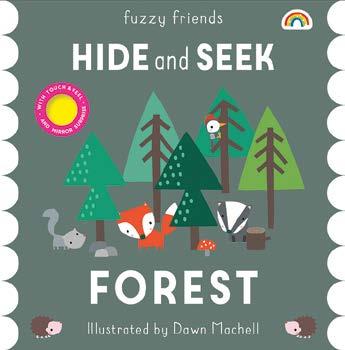






















































































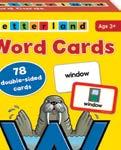



















Enjoy stimulating those fine motor skills and help your kids develop their connection with nature. Pressed botanical collages are a fun and creative way to showcase your homegrown glory. Frame your art and hang it up around your home for all to admire.
By Life is a Garden• Frames with glass: You can use multiple smaller frames or go for one large artwork. Consider a sleek white or deep purple frame to compliment the pastel colours of the preserved flowers.
• Backboard: This is what you will use to create your collage on. You can find thick cardboard in a variety of colours at your local stationery shop. Once again, a plain white or deep purple would work well for an overall sleek look, whereas bright greens or blue cardboard would give it more of a stylised feel.
• Clear-drying craft glue: Once all your plant pieces have dried, the glue will be used to stick them onto the cardboard sheet.


• Paper towels or fabric: These materials will be used on both sides of your flowers during pressing for protection and moisture abortion.
• Pressing materials: These could be big books or slabs of wood or bricks. Anything heavy will work well, provided you protect both sides of your flowers with a paper towel or fabric.

• Flowers: Fynbos and proteas work particularly well as their colour holds nicely and the added texture creates a more 3D look. Our top flower picks for pressing are:
o All fynbos and protea varieties

o Peony, roses, heliobore, Queen Anne’s lace, astilbe, seeded eucalyptus, dahlias, ranunculus, lavender, as well as peonies, roses, ranunculus, and hydrangea.
Avoid using anthurium, orchids, lilies, plumeria, and succulents as they hold a lot of excess moisture, which makes them very challenging to preserve properly. Once pressed, white flowers will turn to a more winter white, so keep this in mind when selecting colours. Go for richly coloured blooms that will turn to deeper shades once preserved.
The most important part of capturing the full shape and dimension of your protea is actually to press the parts individually. Once dried, you will be able to reconstruct your centrepiece flower to better mimic its original glorious form. Begin your pressing process by carefully taking apart the major elements of your protea. Other smaller flowers and foliage can be left as is, but it is nice to also have individually pressed leaves for later detailing and texture.
Once you have all the pieces of your protea and accompanying flowers, prepare your chosen pressing environment by placing your paper towel or fabric on the bottom surface. Place all your plants on the paper towel or fabric and then place another layer of material over them.
Place the top part of your chosen pressing slab/brick/book on top of your arrangement and allow it to completely dry for 3 to 4 weeks.
Remove all your plant pieces and begin planning your bouquet on the cardboard. You can really get creative here and use anything from calligraphy pens to ribbons and other craft paper to accentuate and personalise your design to suit your décor style.


Once you are happy with the design, apply a small amount of glue to the back of the plant pieces and watch as your organic masterpiece comes to life.

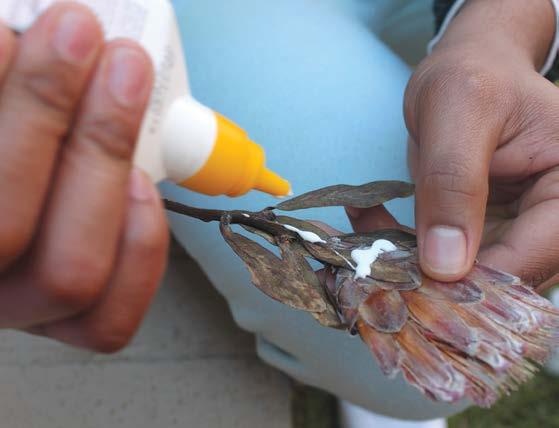
TOP TIP: To test if your plants have dried enough, see if they crack when you try to bend them. It’s a good idea to include some extra test pieces during the pressing process to use as your sacrificial plants. This will help you determine if your arrangement has dried properly.
 Place the cardboard back into the frame and secure the glass. Your botanical artwork is now ready for the wall!
Place the cardboard back into the frame and secure the glass. Your botanical artwork is now ready for the wall!




















If your infant or child experiences a sudden bout of diarrhoea caused by an infection it can be a serious problem which can lead to dehydration.1

Diarrhoea is often a consequence of a disturbance of bowel gut flora which can occur during an infection or antibiotic treatment.2
INTEFLORA contains a probiotic known as Saccharomyces boulardii CNC I-745 that:


























• Improves the consistency of stools and is well-tolerated.







• Significantly reduces the duration of acute diarrhoea in infants and children
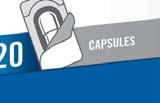




Trust INTEFLORA 250, indicated for antibiotic-associated diarrhoea and non-specific sudden diarrhoea. Suitable for infants, children, and adults.
1. WHO Diarrhoeal Disease Fact Sheet. Diarrhoeal Disease. World Health Organisation. [updated 2017 May 02; cited 2022 August 01] Available from: https://www.who.int/news-room/factsheets/detail/diarrhoeal-disease 2. Neut C, et al. Antibiotic susceptibility of probiotic strains: Is it reasonable to combine probiotics with antibiotics? Med Mal Infect. [updated 2017 November 10; cited 2022 August 01] Available from: http://dx.doi.org/10.1016/j.medmal.2017.07.001 3. Billoo AG, et al. Role of a probiotic (Saccharomyces boulardii) in management and prevention of diarrhoea. World Journal of Gastroenterology. [updated 2006 July 28; cited 2022 August 01] Available from: https://www.wjgnet.com/1007-9327/full/v12/i28/4557 4. IQVIA MIDAS 2020 (ATC: A7F) & IQVIA OTCims 2020 (OTC: 03F1/03D5) & Deduplication.





S0 INTEFLORA 250 (capsule). Ref. No.: T194 (Act 101/1965). Each capsule contains 250 mg lyophilised cells of Saccharomyces boulardii CNCM I-745® Trademarks are owned by or licensed to the Aspen Group of companies. © 2022 Aspen Group of companies or its licensor. All rights reserved. Marketed by Pharmacare Limited t/a Aspen Pharmacare Co. Reg. No.: 1898/000252/06. Healthcare Park, Woodlands Drive, Woodmead, 2191. ZAR-SAB-07-22-00003 08/2022


While passing a K53 driving test is not the only preparation needed to drive safely on South African roads, it is the only legal requirement to receive a license. It is up to teachers of new drivers to share their experience to develop their skills.
By Adv Johan Jonck, Arrive AliveAccording to research, South African youth are some of the most vulnerable on the roads. The CEO of MasterDrive, Eugene Herbert, explains: “The impatience and recklessness of many drivers paired with inexperienced and new drivers, creates prime opportunities for tragedy.”
Three risk areas
1 Inexperience: experienced drivers should help build their confidence with guidance and patience which will help them identify risks and adjust their driving.
2 Reckless driving: new drivers should not just be told not to speed, drive distracted, forego seatbelts or be aggressive but helped to understand the consequences of this.
3 Further training: defensive driver training develops full awareness and knowledge of evasive techniques that goes beyond K53 theory.
Parents also need to be selective when deciding where to teach learner drivers.
“Increase the difficulty of driving scenarios as experience increases. Gaining experience with a skilled driver is invaluable to create confident and safe drivers. Putting new learners in peak hour traffic, is unwise at best,” Herbert says.
“Use discretion when deciding whether a new driver has enough skill and experience to manage more challenging roads. While gaining this experience under your watchful eye is preferable to them driving these routes in the near future with equally inexperienced passengers, be cognisant certain situations are simply too dangerous for new drivers,” he adds.
As a co-driver, your role is not to kick back and relax. Instead, watch the road as if you were driving. A new driver is unlikely to see the reckless driver or jaywalker as quickly as you and parents should help develop this skill.
Use every trip with your learner driver to create a learning experience. Help develop the ‘muscle memory’ you already have from years of driving so they can drive alone with a great deal more confidence than if you never had this opportunity to share your skills with them.
Additionally, MasterDrive strongly advises against new drivers taking long-distance trips for the first time with only friends for guidance.
“New drivers simply lack the situational awareness experienced drivers have. Studies show experienced drivers perceive and recognise potential hazards much faster than inexperienced drivers – a few minutes delay that can have tragic consequences,” says Herbert.
“Young drivers are also at higher risk with friends in the car. A study by the AAA foundation for Traffic Safety says a teen driver’s risk of death increases by 44% every 1,6km with one teen passenger and quadruples if there are three. The risk is simply too high,” he adds.

Once you impart these skills to your learner driver, it is time to select a driving school.
“Unfortunately, many driving schools have bad reputations for being more concerned about guaranteeing passes through bribery and corruption than what they are about conveying invaluable driving skills,” says Herbert.
“We recommend looking for driving schools accredited with the South African Institute for Driving Instructors. While accreditation is not a legal requirement or a guarantee of quality for driving schools in South Africa, it does hold members to higher standards.”
After that follow these tips:
• Check the credentials and training of instructors.
• Ask for referrals and seek out your own from both friends or acquaintances and online.
• Ask to view a training sessions.
• Do this with more than one potential driving school.
• Once you select one, watch for progress in your child’s driving and react as soon as you do not see adequate progress.
• Be cautious of schools that ‘guarantee’ passes.
• Assessing driving school based on pass rates is not an accurate judgement because too many variables can cause a fail or pass, not just the quality of the school.
Once you pass and receive your driving license, remember that you are still learning. It is estimated that it takes approximately five years to gain enough experience for the roads. Keep these tips in mind to remain safe while you learn.

• Maintain a following distance of at least three seconds.
• Drive looking 12 seconds ahead to anticipate traffic and dangerous situations.

• Always adjust your speed to the conditions irrespective of the speed limit.
• Be aware of your surroundings at all times.
• Never drive under the influence of alcohol or drugs.
Most parents invest a great deal of years and money into developing well-adapted adults. “Not giving them the best training and skilled guidance is a mistake and can even be considered short-sighted and neglectful,” emphasises Herbert.
The cost of solar energy systems, inverters, generators, and UPS devices is out of the price bracket for many households. Here are some budget-friendly tips to help cope with the ongoing loadshedding.
Keep a couple of decent-quality power banks charged in case your phone battery or small gadgets need a charge to stay operational.
Let there be (some) light Decent rechargeable camping lights can last a few hours. It’s recommended to invest in more than one so that way you have a backup in case the one runs out of battery life – a power bank can be used to charge some of these.
You also have the option of buying some rechargeable globes that charge when the power is on and will operate when the power goes out.
Solar lights for the outside area are a good investment. This helps when you come home in darkness during loadshedding .
A torch in every room is a good idea – keep some extra batteries for these.
There are also a variety of LED lamps for kids to keep next to their beds that are easy to switch on/off. Some are powerful enough to continue with a bedtime reading routine.
A good go-to for many people is to braai, but it can get a bit tiring to braai several times a week. A gas stove works well, but if not in the budget, a
mini camping one-plate gas stove can work for a simple meal or to boil some water.
While there are sometimes last-minute changes to the loadshedding schedule, for the most part you can adequately plan ahead. Chicken/egg/tuna mayo sandwiches don’t require heating if prepped in advance!
Invest in a couple of flasks – these can be used for boiled water for hot drinks, or to make a baby’s bottle. Flasks are also a good plan to keep soups warm.
Many kids enjoy picnics – be it indoors or outdoors. Kids can also help prep the set-up.
With up to four hours of loadshedding at a go, a natural worry for many parents is food spoiling or not being cool enough.
• Try not to open the fridge or freezer unless absolutely necessary.
• Fill a few 2-litre bottles with water and freeze in advance. When loadshedding kicks in, place these in the fridge to help keep food cool.
In place of ironing, hanging up clothes carefully can minimise creases.
Considering the heater will not be on at certain times, ensure there are sufficient blankets and warm clothing to keep snug.
A small inverter or UPS can be budgetfriendly to power up things like Wi-Fi, which can assist kids with doing their homework or staying entertained.
Some ideas for family time could be to walk kids and pets during loadshedding (provided it’s safe to do so, and not too cold).
Board games can be great for family bonding, as can arts and crafts projects.
If you have apps like Disney+ and Netflix, shows and movies can be downloaded in advance and watched on a laptop or tablet.

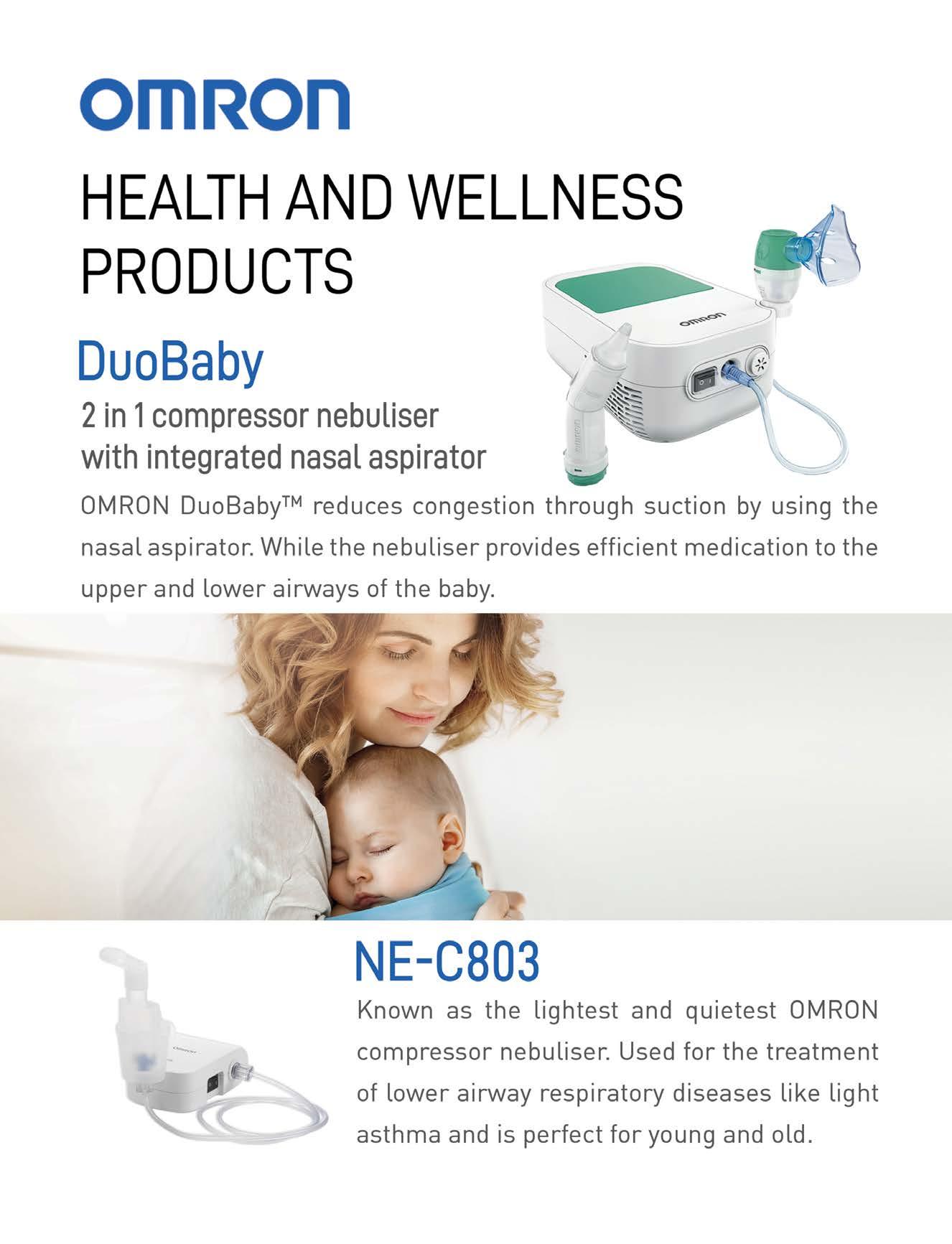
a r q w e e r h e a l t h y r w g k i l
b c e o v e r e a t i n g q d t r e p w
l r n b e t e w t y q x c a y g e b e x
o r o f g e h j d s w a s w s v i r r t
a n m n e t e y u i o p v k r i m y i u
d m e w c s f r e h r x i c e c p e l g
s j y r e h d j k i m r s q g d e s s a
h x c r d r i v e r s w i h u b t e w w
e m u r w q e o r a l w o y l f i w p q
d g h r w e s a l c v e n q a t g h r u d t t e s t i n g i q w l i t q o z o x i g h j y r e t u i t h k l i j f w t s n e q g t y k l o z s i b n o f r t e h g i v e a w a y y e r e s w n q e r a b j u q w e h y u i j b f s e s e e w s o n i o p i f t y t e f g t l e s s o n s k o i l t l r t p r o t e c t i o n q h h e j u b u t t e r f l y n j u t r e w a m o m e n t u m y u r w e u o p q w q
bronchiolitis

butterfly drivers
dysregulation flu
giveaway


healthy impetigo lessons


loadshedding momentum
oral overeating perils
proteas protection testing
vision worms


• 4 tablespoons butter
• 1 tablespoon oil
• 1 medium onion, diced
• 4 cloves garlic, minced
• 400g chopped mixed mushrooms
• 4 teaspoons chopped thyme, divided
• ½ cup white wine (optional)
• ½ cup flour

• 2 cups chicken or vegetable stock
• pinch of salt to taste
• crushed black pepper to taste
• 1 cup heavy cream
• chopped fresh parsley and thyme to serve
1. Heat butter and oil in a large pot over medium-high heat until melted.
2. Sauté onions for 2 to 3 minutes until softened. Add garlic and cook until fragrant, about 1 minute.
3. Add mushrooms and 2 teaspoons thyme. Cook for 5 minutes. Pour in wine and allow to cook for 3 minutes.
4. Sprinkle mushrooms with flour, mix well and cook for 2 minutes.
5. Add stock, mix again and bring to a boil. Reduce heat to low-medium heat, season with salt and pepper.
6. Cover and allow to simmer for 10-15 minutes, while stirring occasionally, until thickened.
By Dimakatso7. Reduce heat to low, stir in cream. Allow to gently simmer (do not boil).
8. Adjust salt and pepper to your taste. Mix in parsley and remaining thyme.
educational, fascinating for young and old, and is guaranteed

The Two Oceans Aquarium’s magical exhibits with their vibrant colours and movement are not only awe-inspiring for children of all ages, but also provide great family-friendly activities. Have fun exploring interactive exhibits like the touch pool. Experience feeding of the animals, and visit our play centre with puppet shows and arts and crafts.








• 1kg beef short rib
• 1 tablespoon oil
• 1 onion, diced
• 5 celery sticks, chopped.
• 1 tablespoon crushed garlic
• 3 bay leaves
• 3 potatoes, chopped
• 1 tablespoon black pepper
• 1 tablespoon paprika
• 2 tablespoons Seven Colours grill spice
• 1½ beef stock cubes
• 4 tablespoons tomato paste
• 2 tablespoons Worcestershire sauce
• 500ml hot water

• handful of fresh parsley (finely chopped)
1. Heat oil and brown meat on both sides, then set aside.
2. In the same pan, sauté onions, garlic, celery, and bay leaves until the onion and celery are soft.
3. Season with all your spices, then add the tomato paste, sauce and stock cube and stir.

4. Add the meat and stir until the meat is fully covered.
5. Pour in water and cover pot with lid and cook on low heat for 1 hour 30 minutes.
6. Halfway through, add the potatoes and cover the pot and leave to cook for another 45 minutes.
7. Once the meat is tender and the sauce has reduced, stir in the fresh parsley and turn off the heat.
 By ThilivhaliMashMugwena
By ThilivhaliMashMugwena
Serves: 5-6
Preparation time: 15 minutes
Cooking time: 1hr 40 min
Actswithin


Suitable Try Lennon Glycerine Suppositories for expected relief within 15-30 minutes.



Acts within 15-30 minutes.
Suppositories are generally more convenient in children and in adults who find it difficult to swallow.


Lennon Glycerin Suppositories for Infants and Children is suitable for children under 6 years.

• 2 cups (500ml) all-purpose flour
• 1 teaspoon baking powder
• 1½ teaspoons baking soda

• pinch of salt
• 1 cup sugar
• 2 eggs
• 1 cup cream
• 2 tablespoons butter or margarine
• 3 tablespoons apricot jam
• 1 cup milk
• 2 tablespoons vinegar
• 3 tablespoons butter
• 1 teaspoon vanilla essence
By TshepisoGabiKgole• 3 tablespoons sugar
• 1 teaspoon vanilla essence
1. Pre-heat the oven to 180°C and grease the baking dish.
2. In a bowl, melt your butter using the microwave.
3. Add sugar, apricot jam and vinegar to the melted butter and set aside to allow the mixture to cool down.

4. In a different bowl, sift the dry ingredients together.
5. Add the eggs and milk to the butter mixture and whisk.
6. Add the wet ingredients to the dry ingredients to create a batter. Be careful not to over mix.
7. Pour the batter into the prepared dish and place in the oven.
8. Bake for 30 minutes until the pudding is dark brown and baked through (a skewer inserted should come out clean).
9. While the pudding is baking, prepare the sauce.
1. Bring all the ingredients to a boil and reduce the heat.
2. Allow to simmer for 3 minutes.
3. Pour the sauce over the pudding as it comes out of the oven.
4. Allow to stand for 10 minutes.
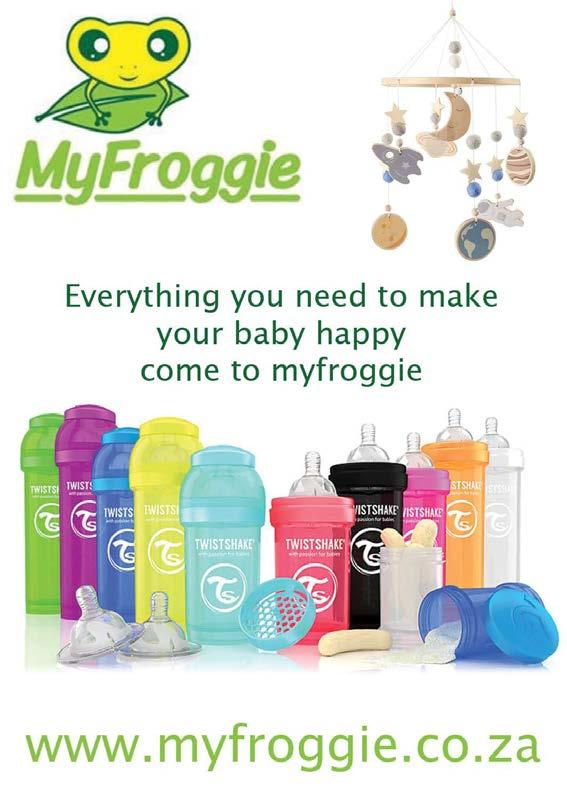



































Dermatologist Approved


2.

3.
Perfume








